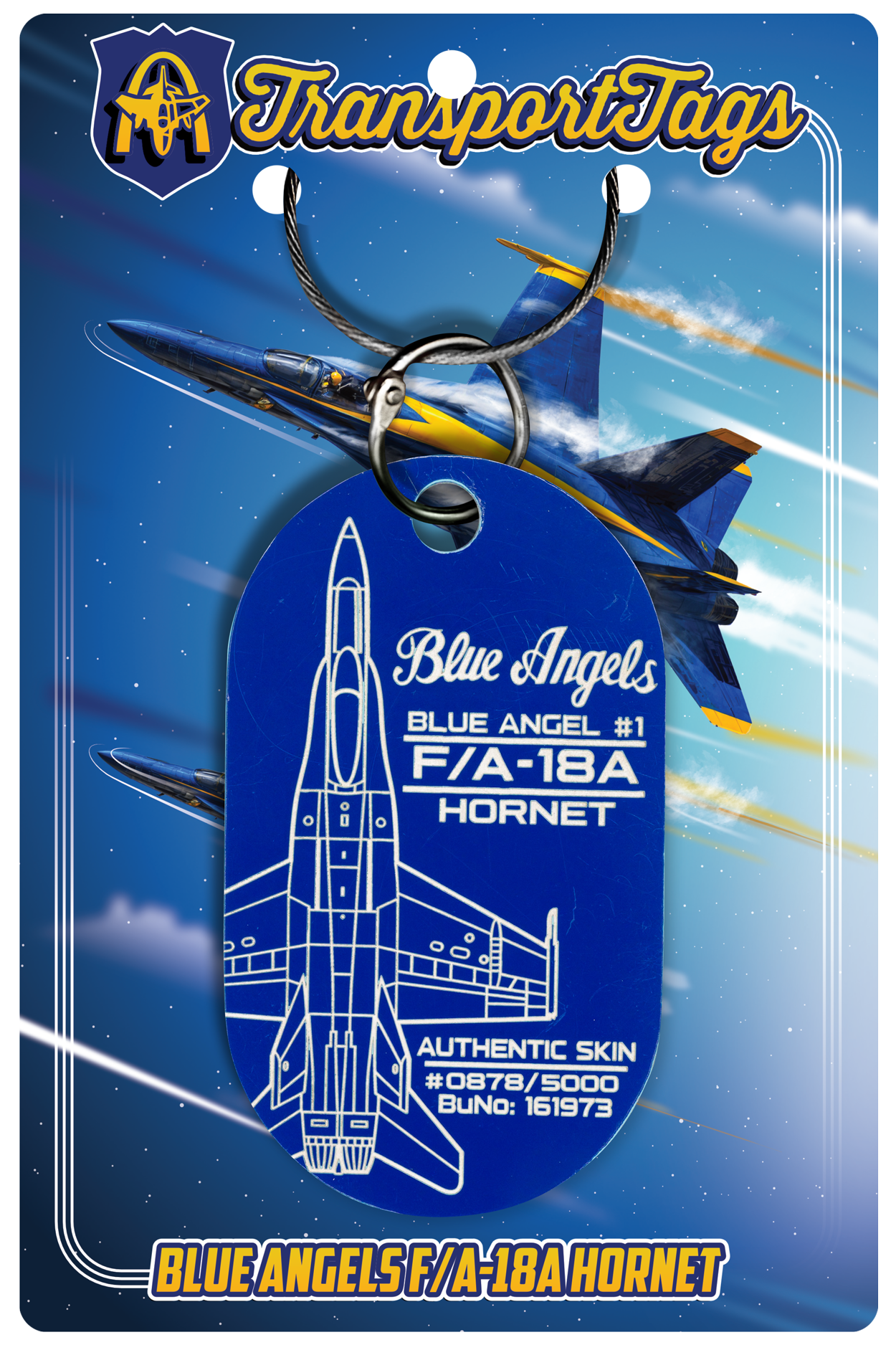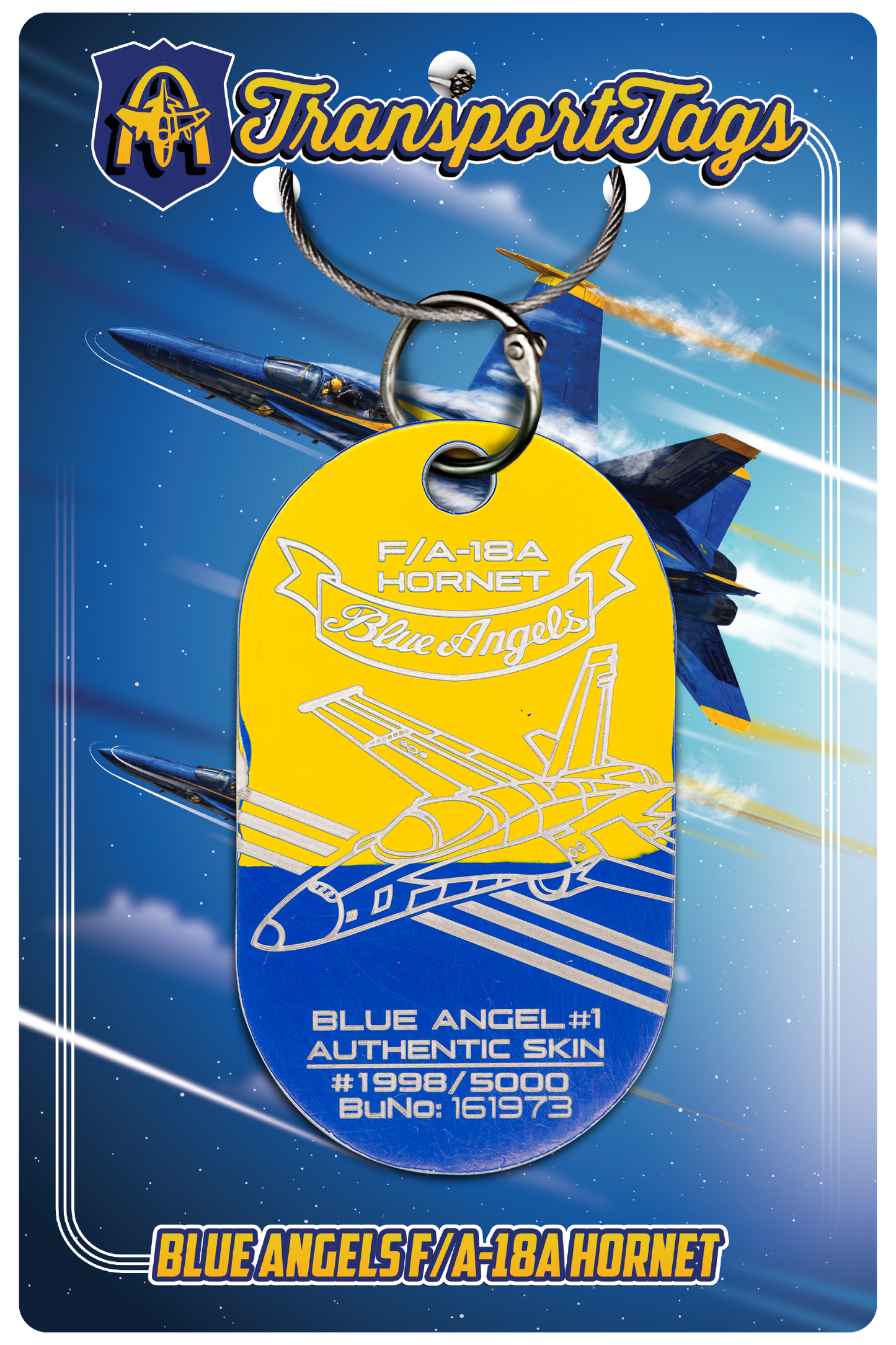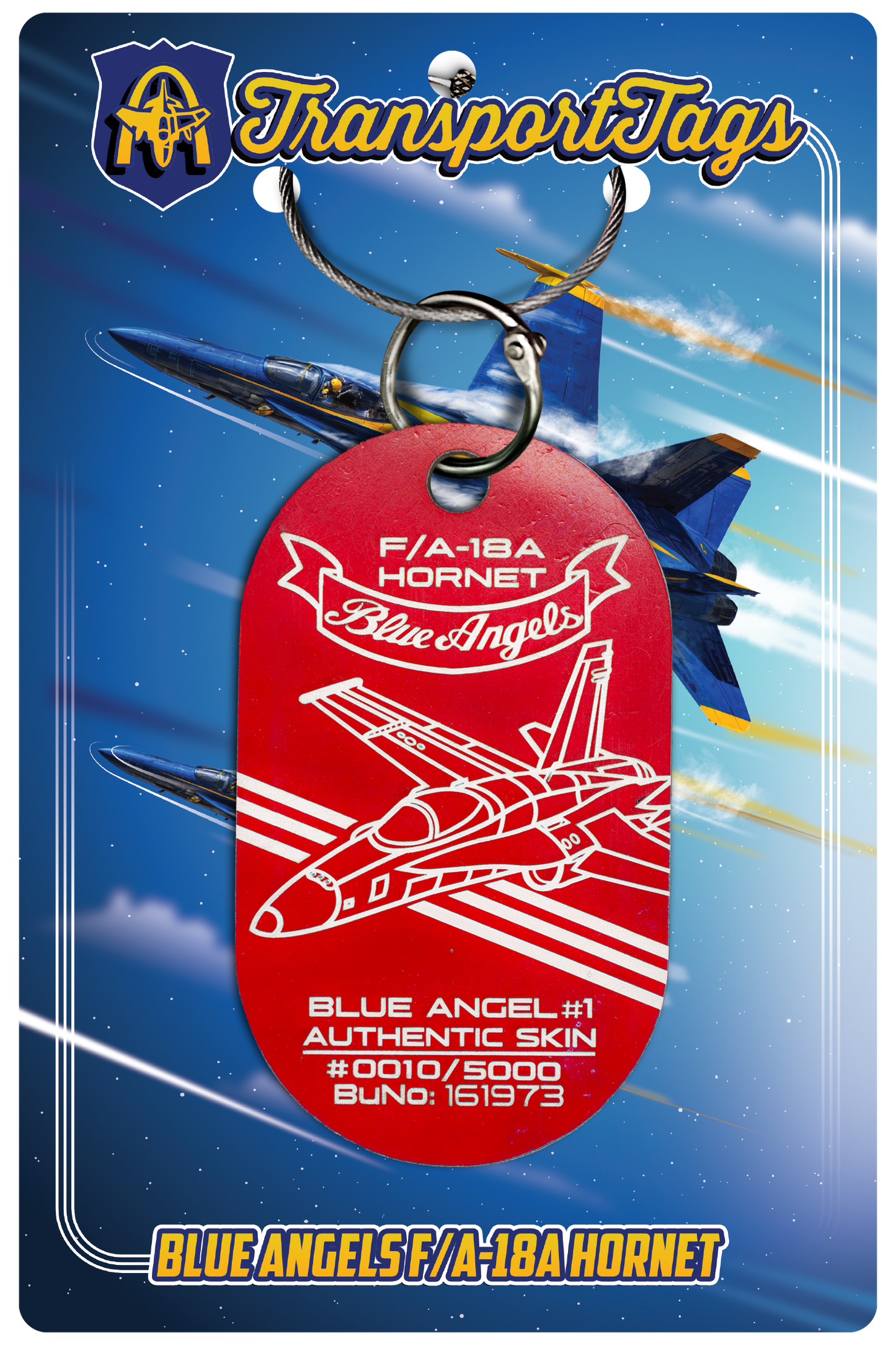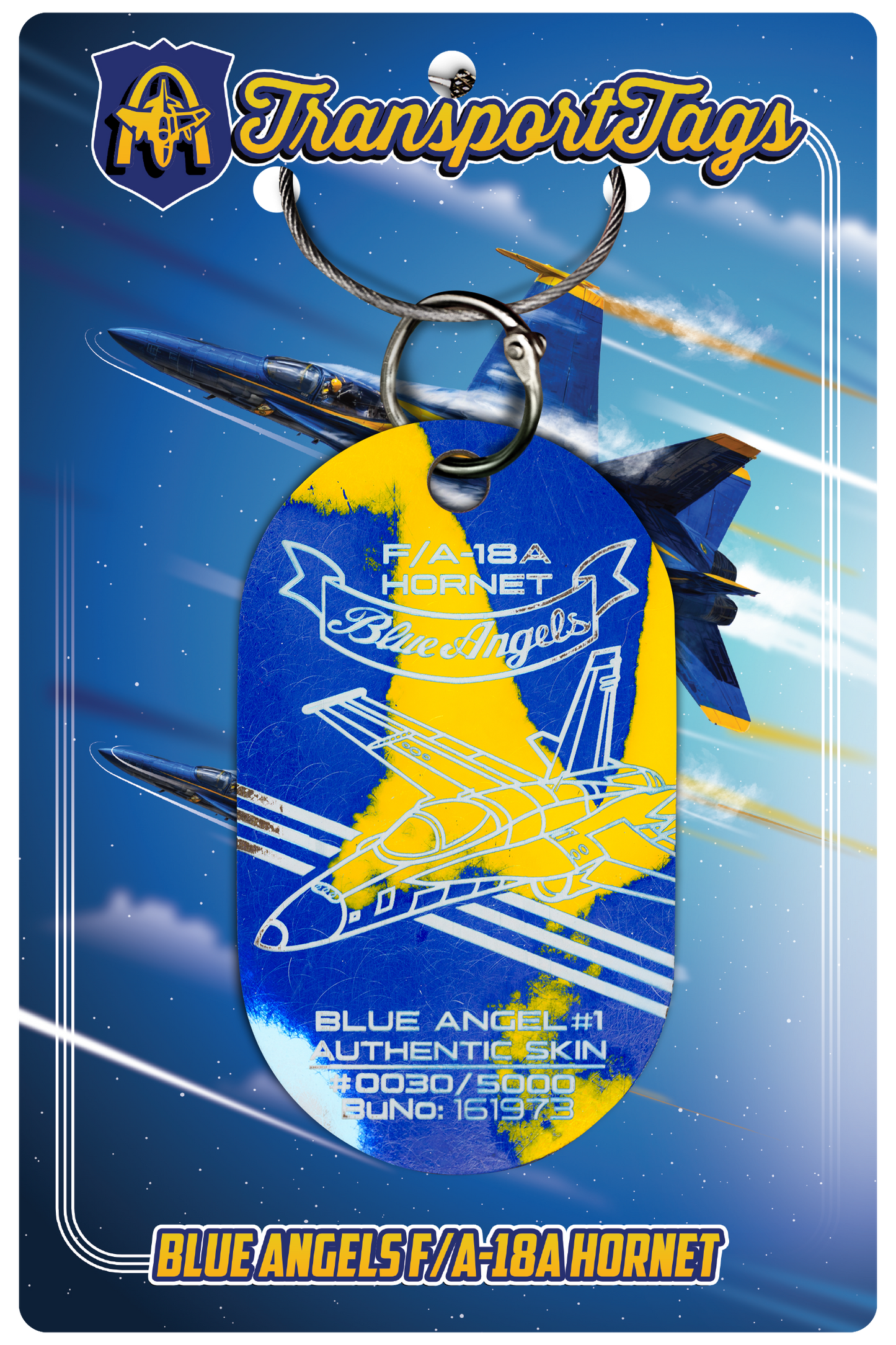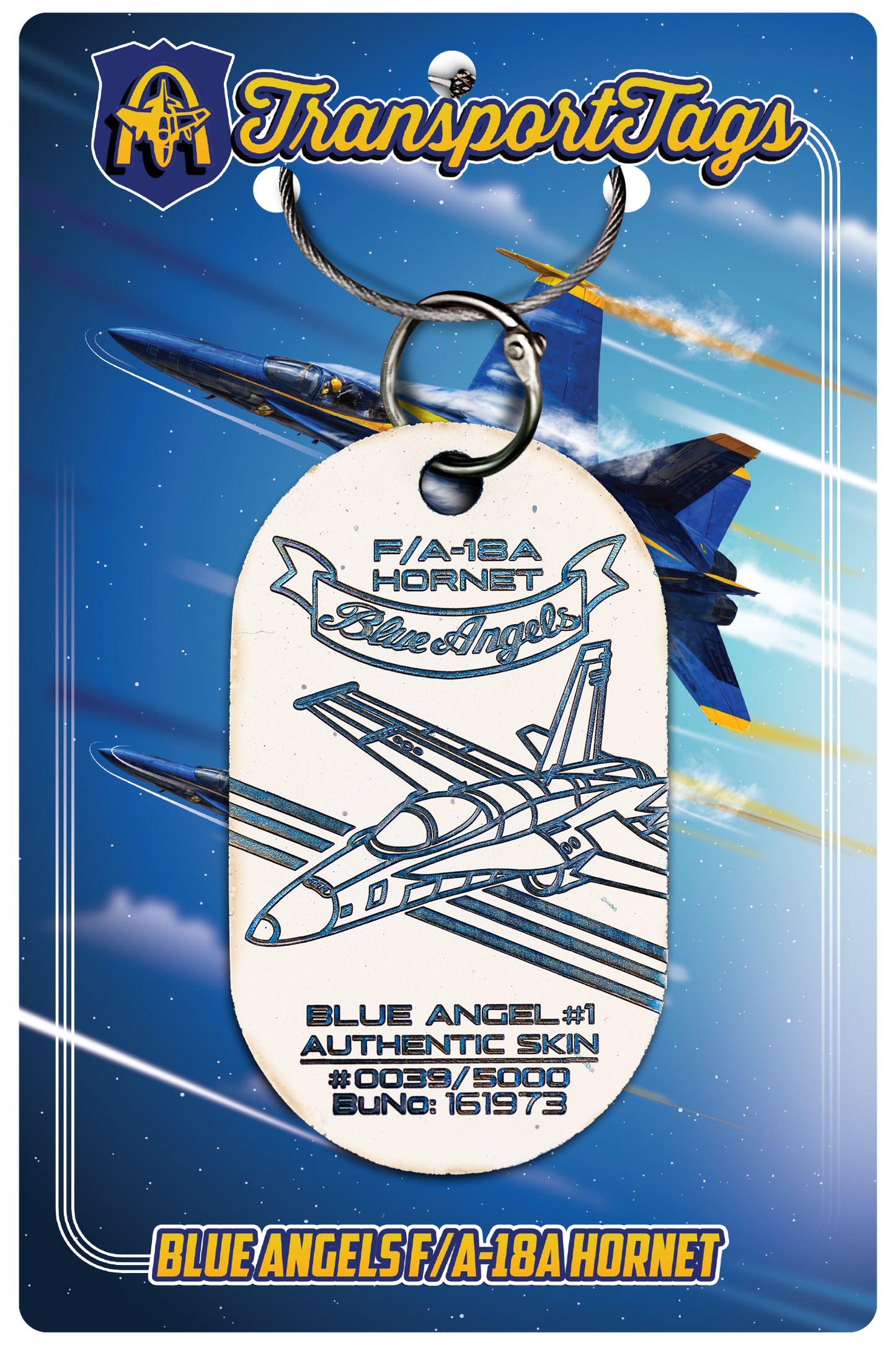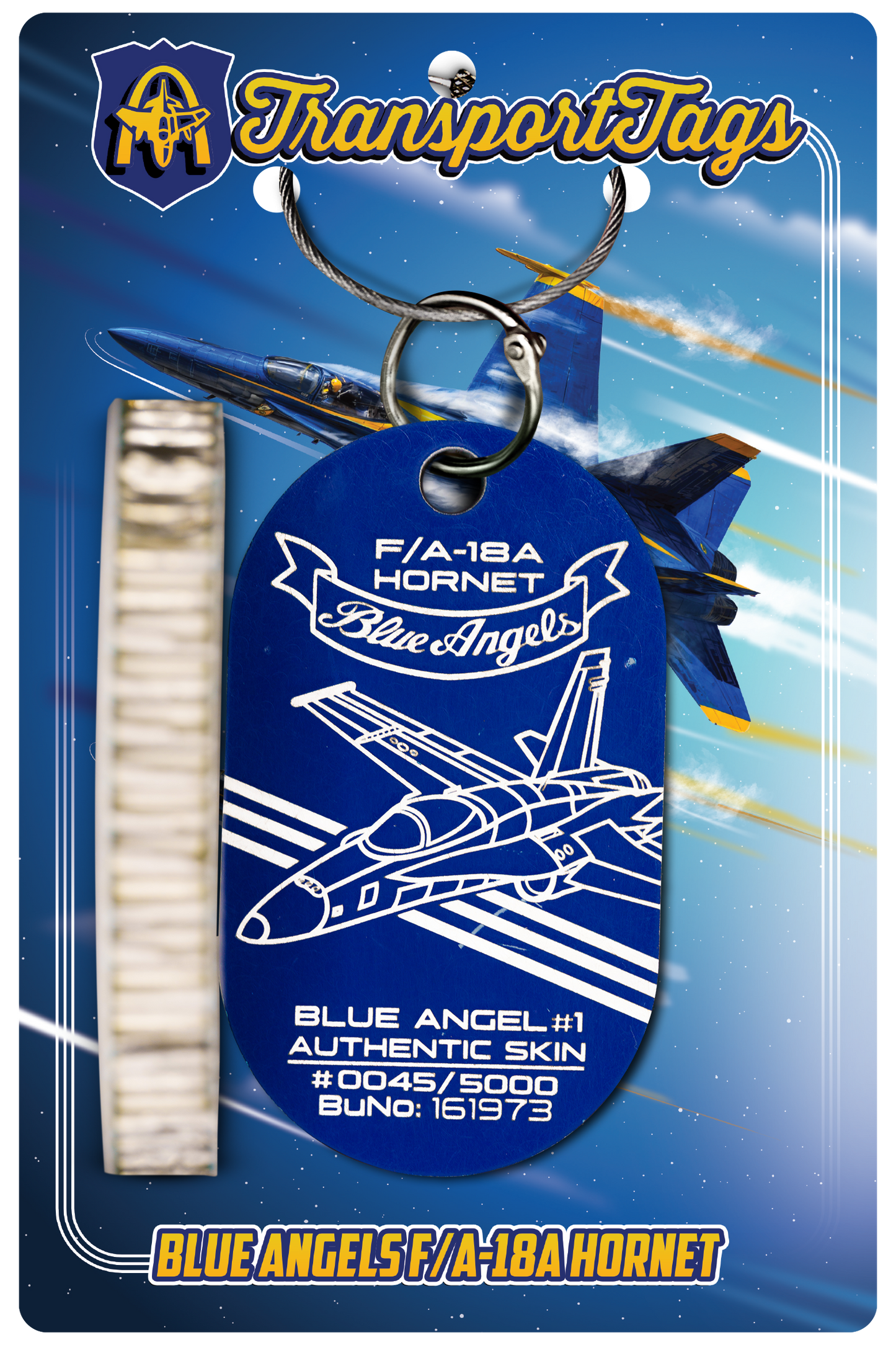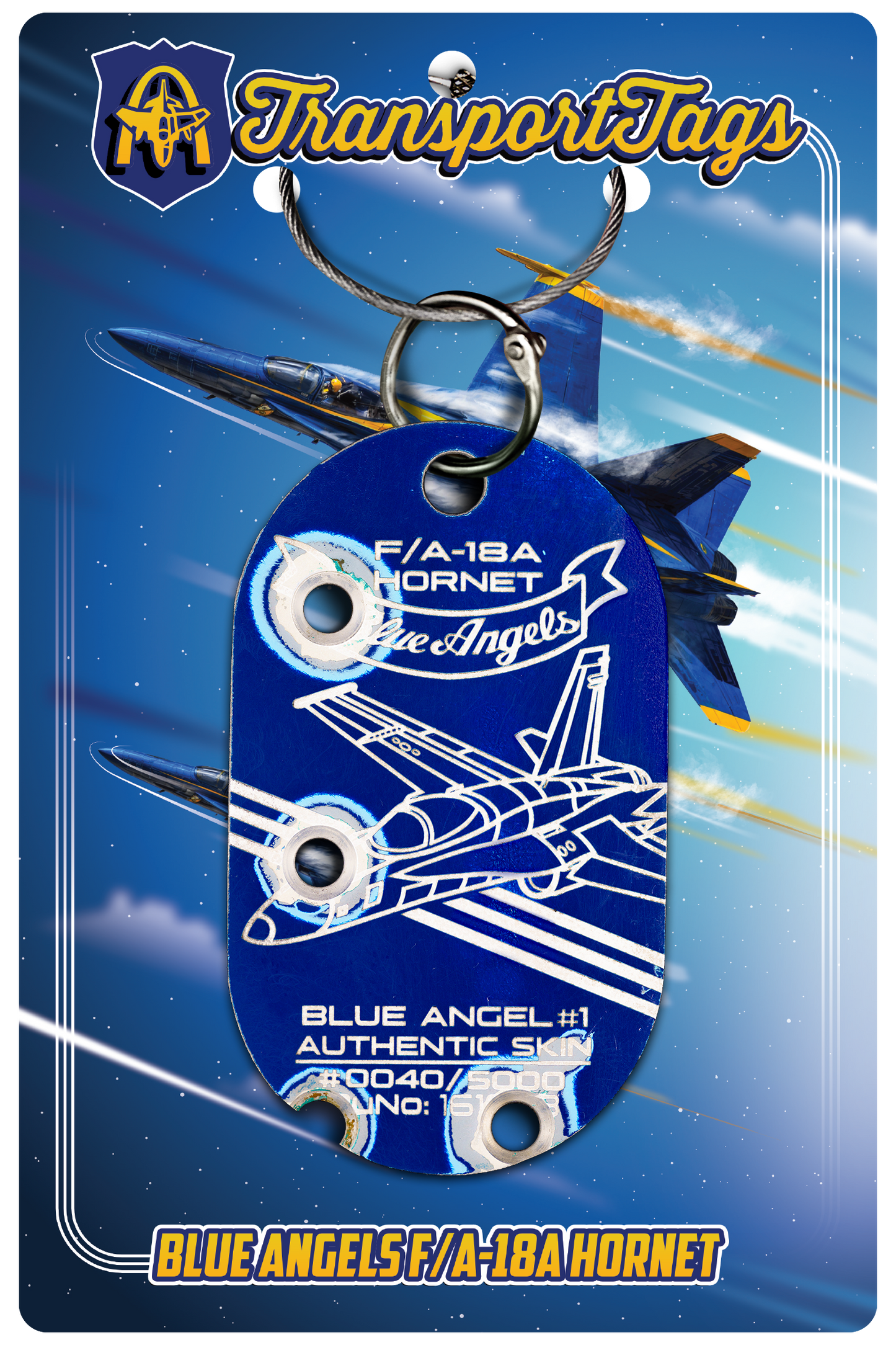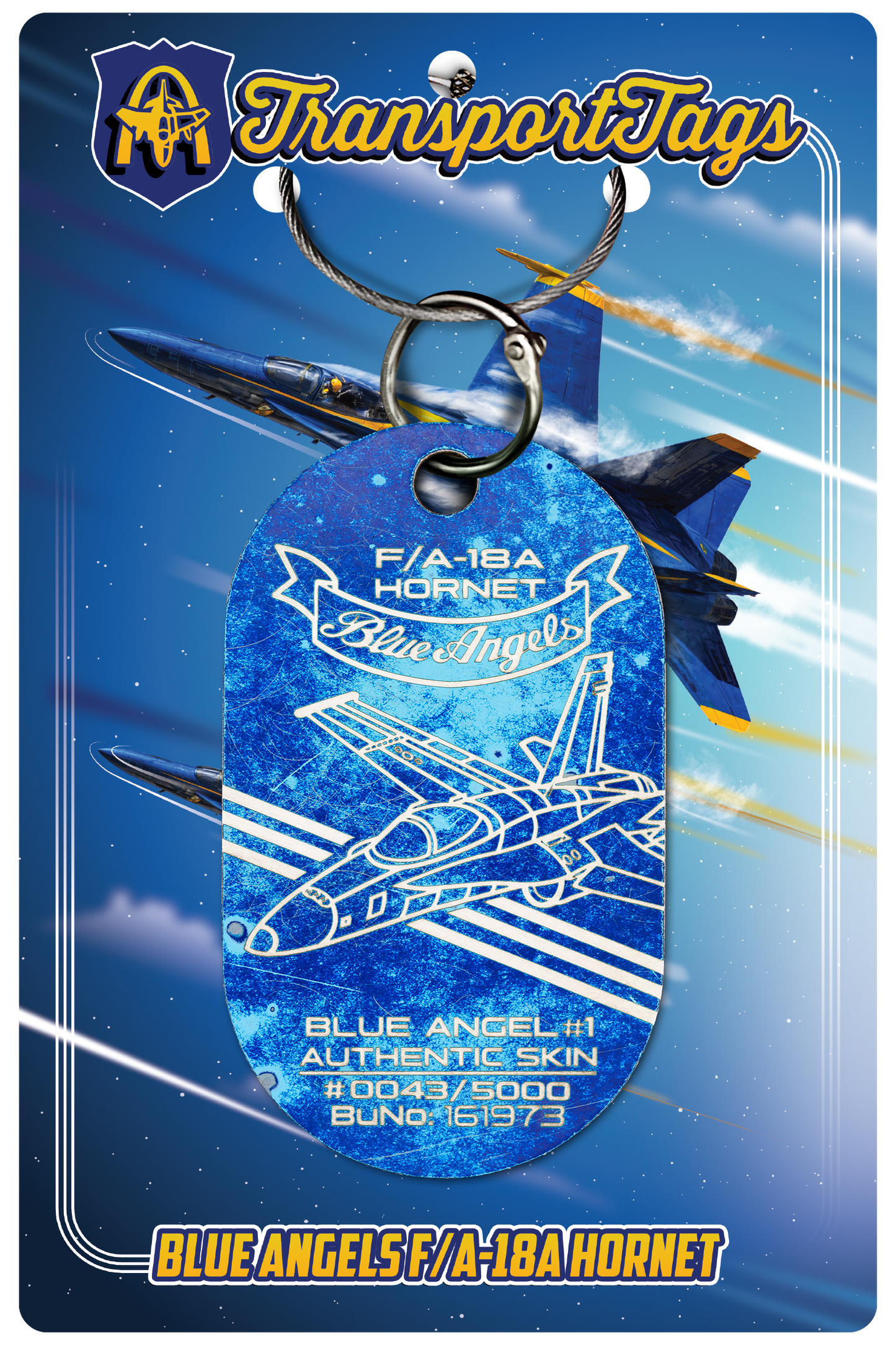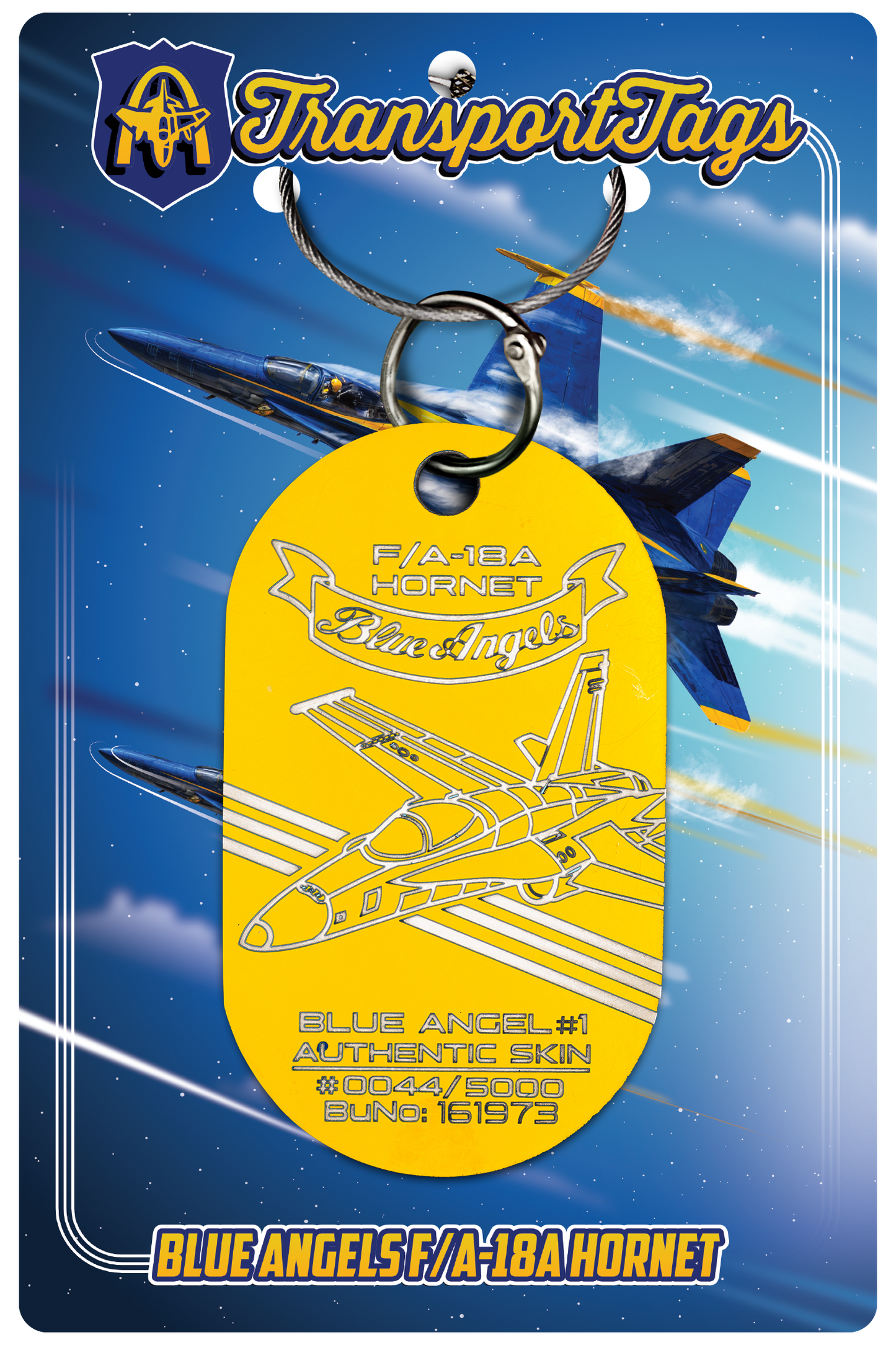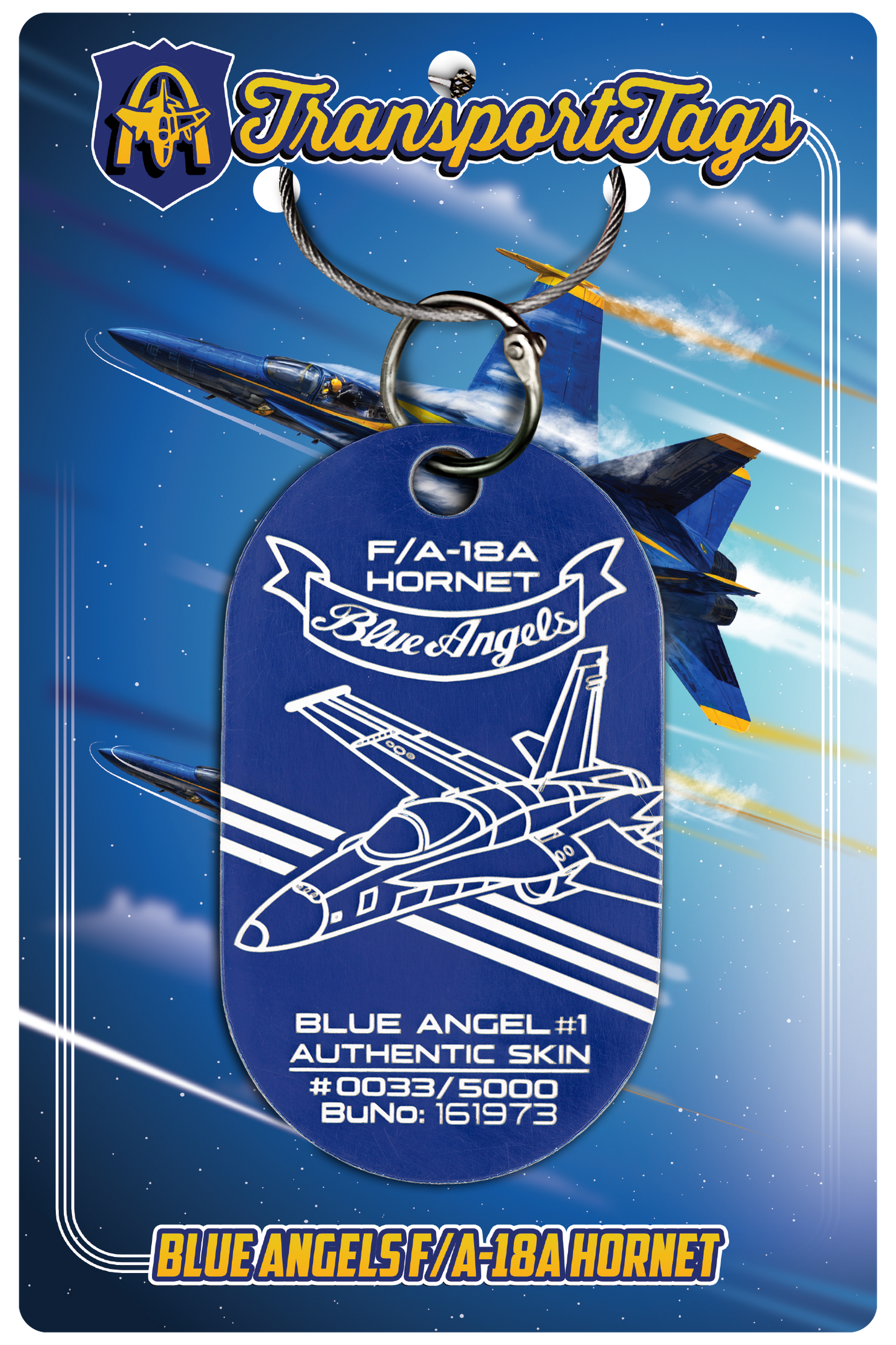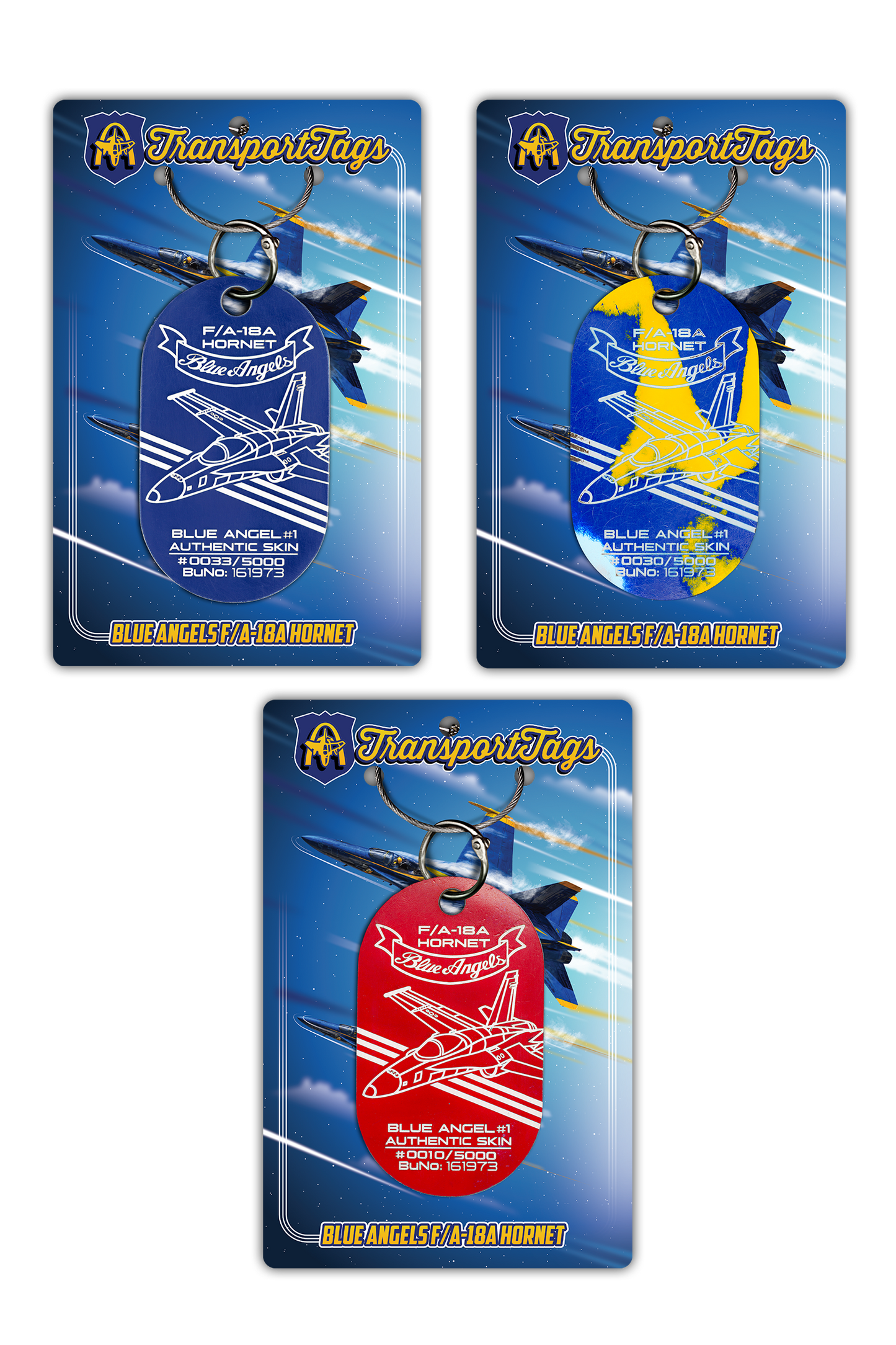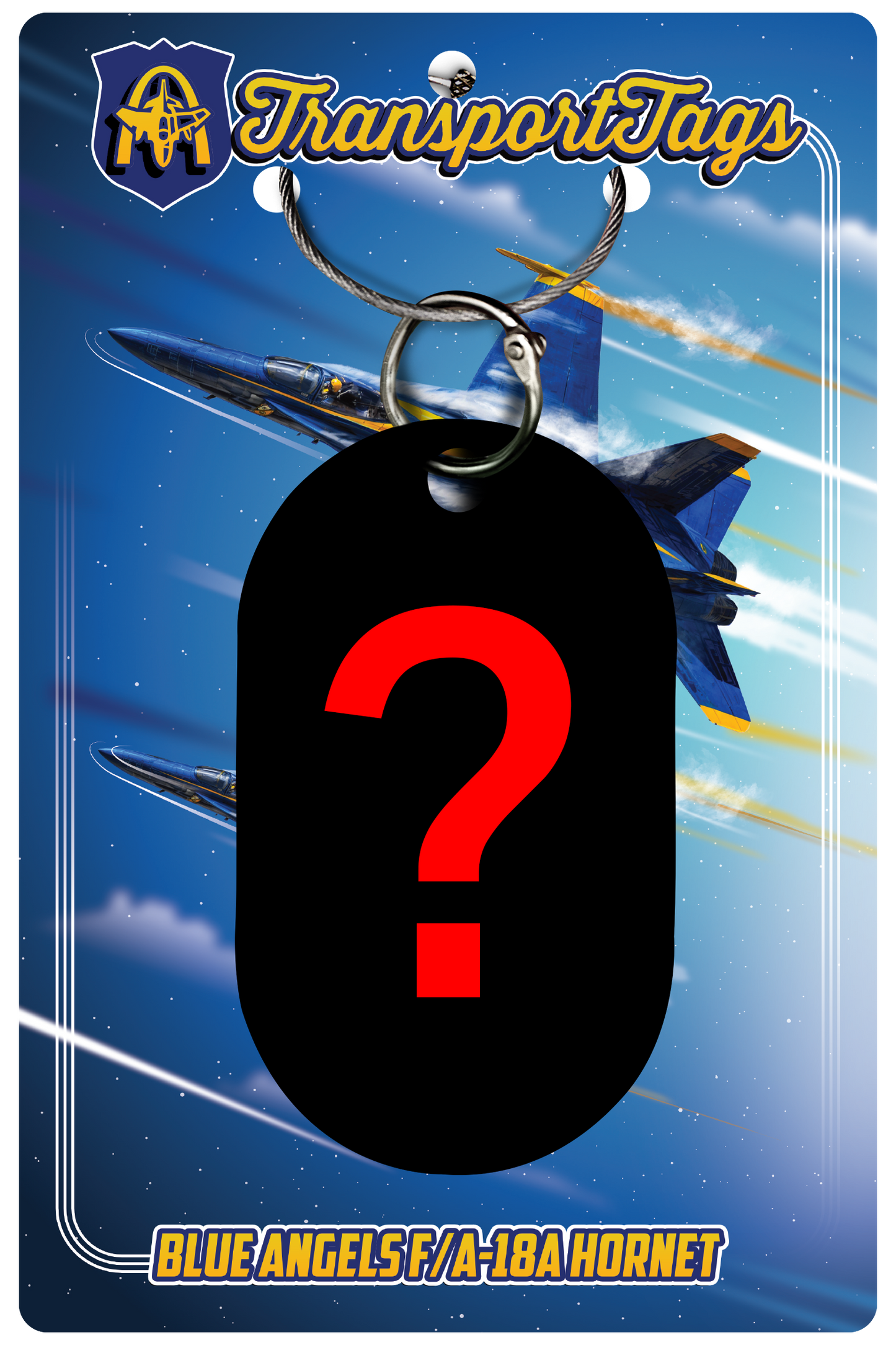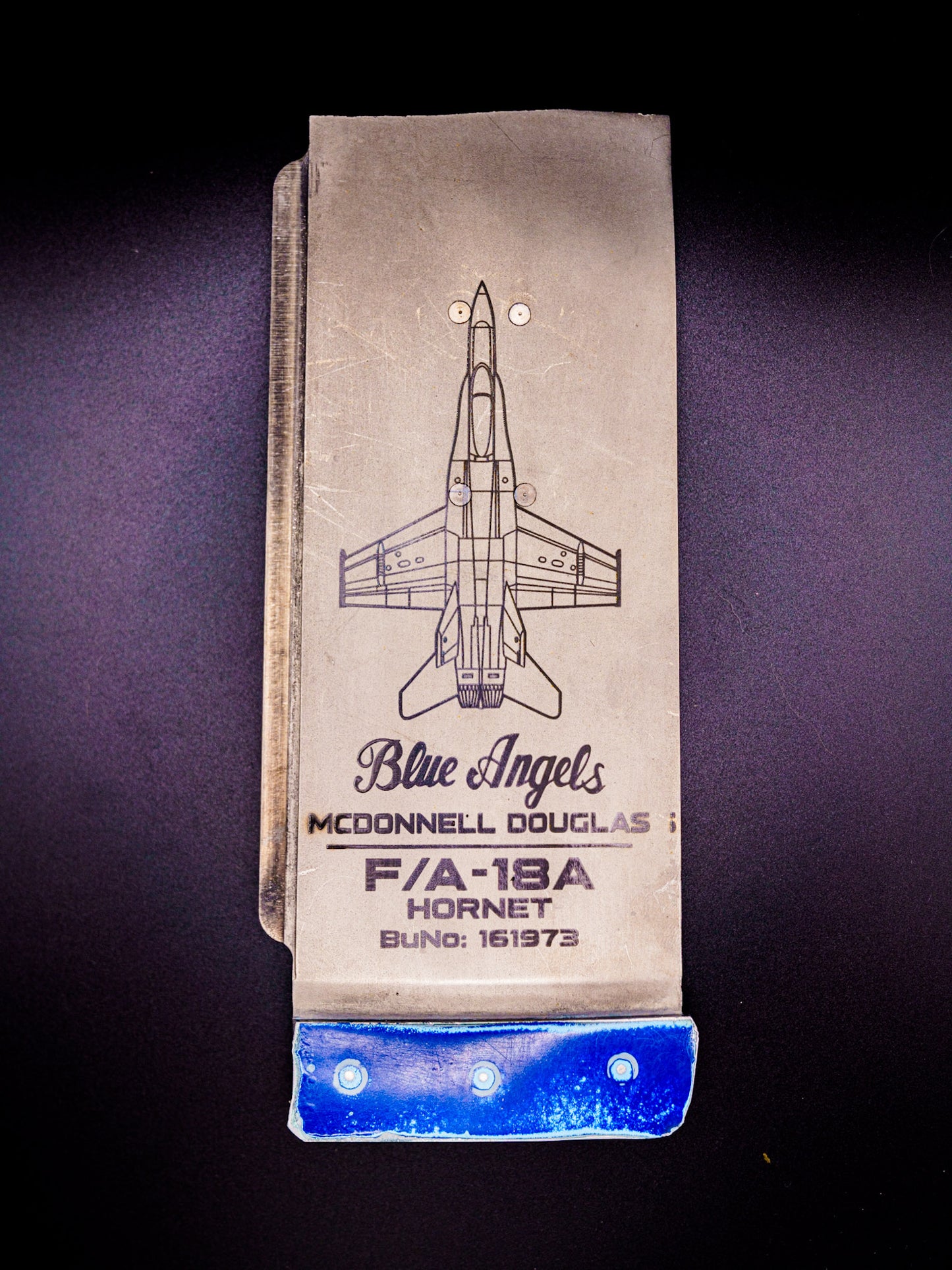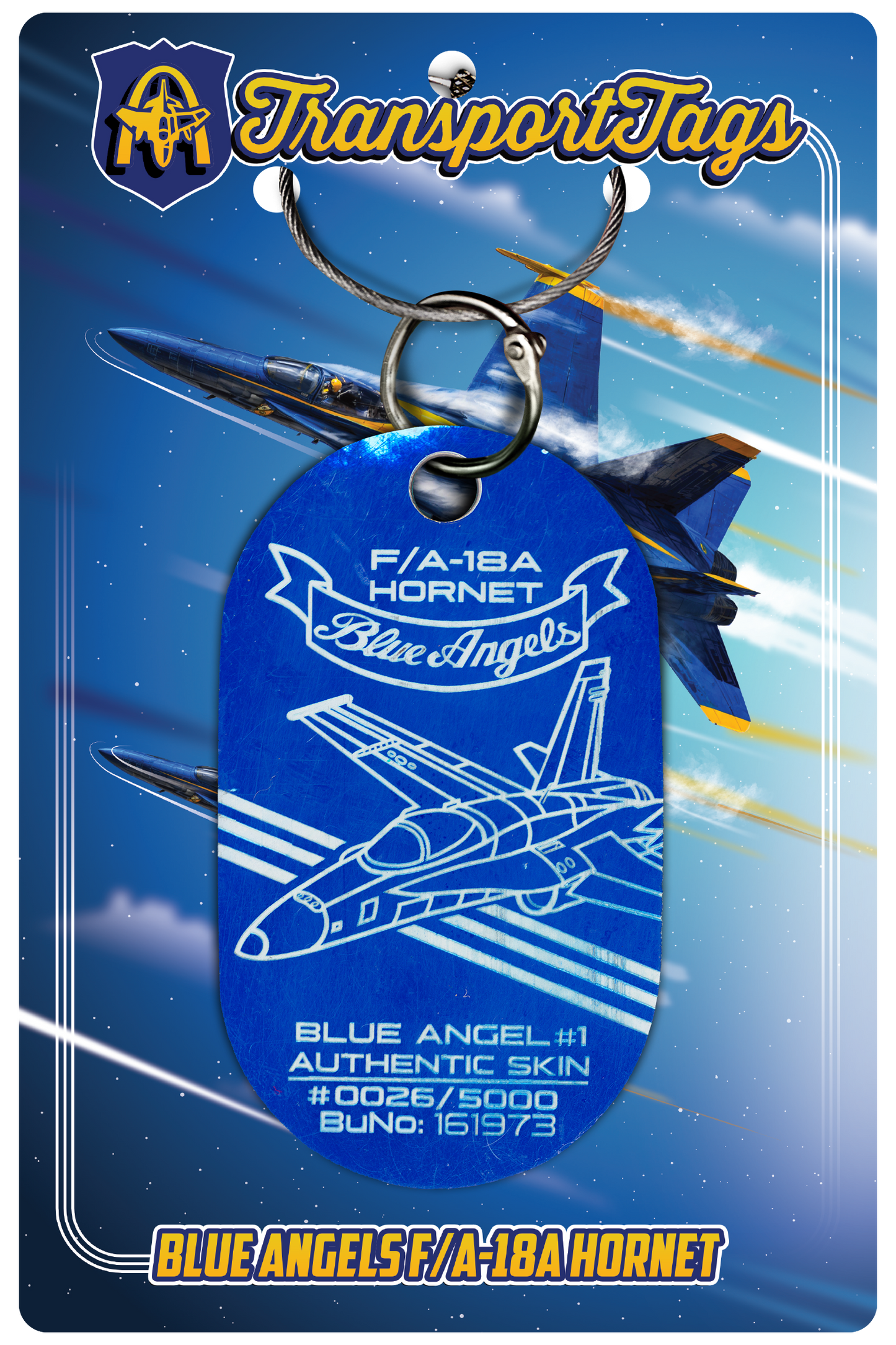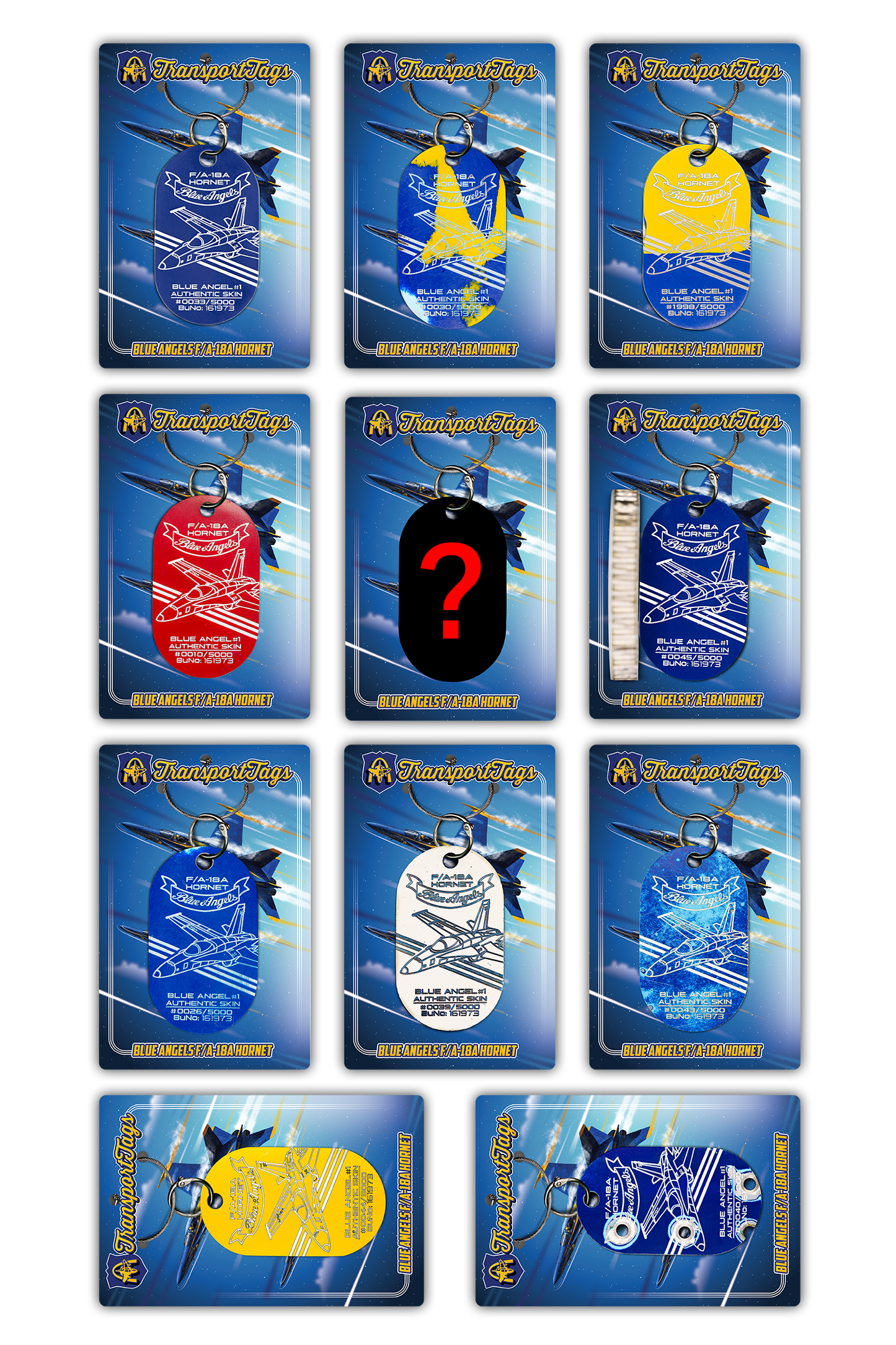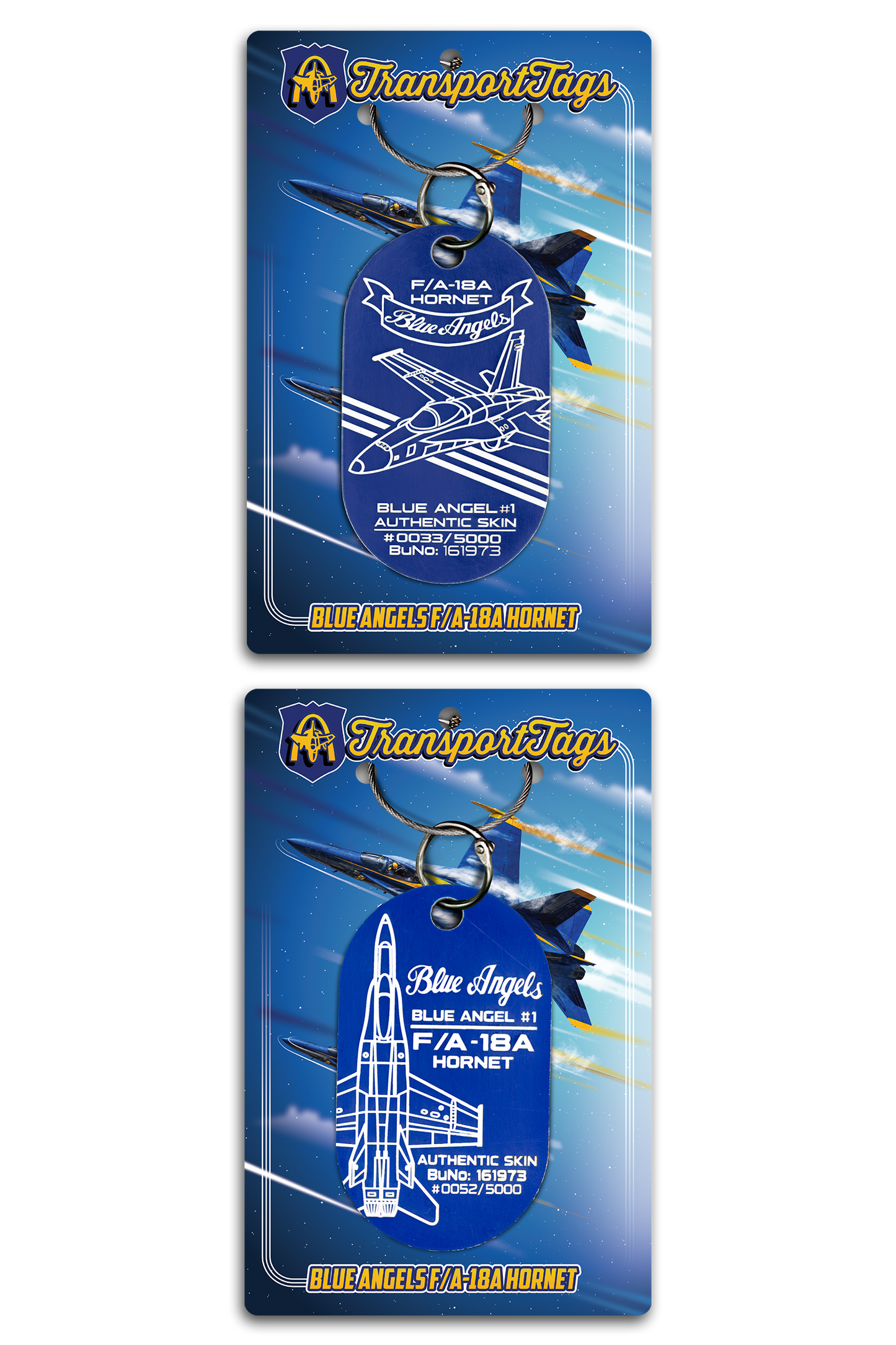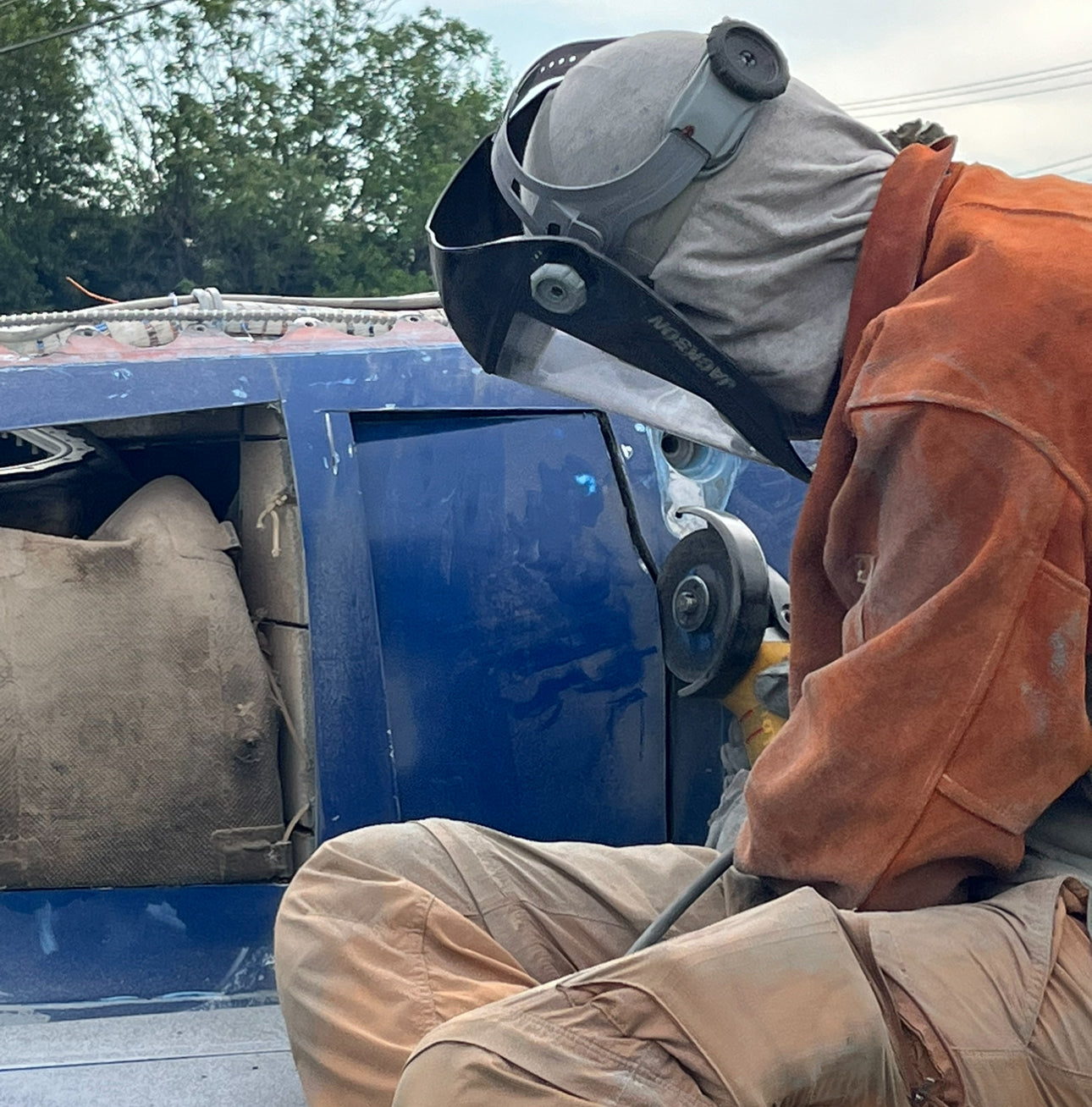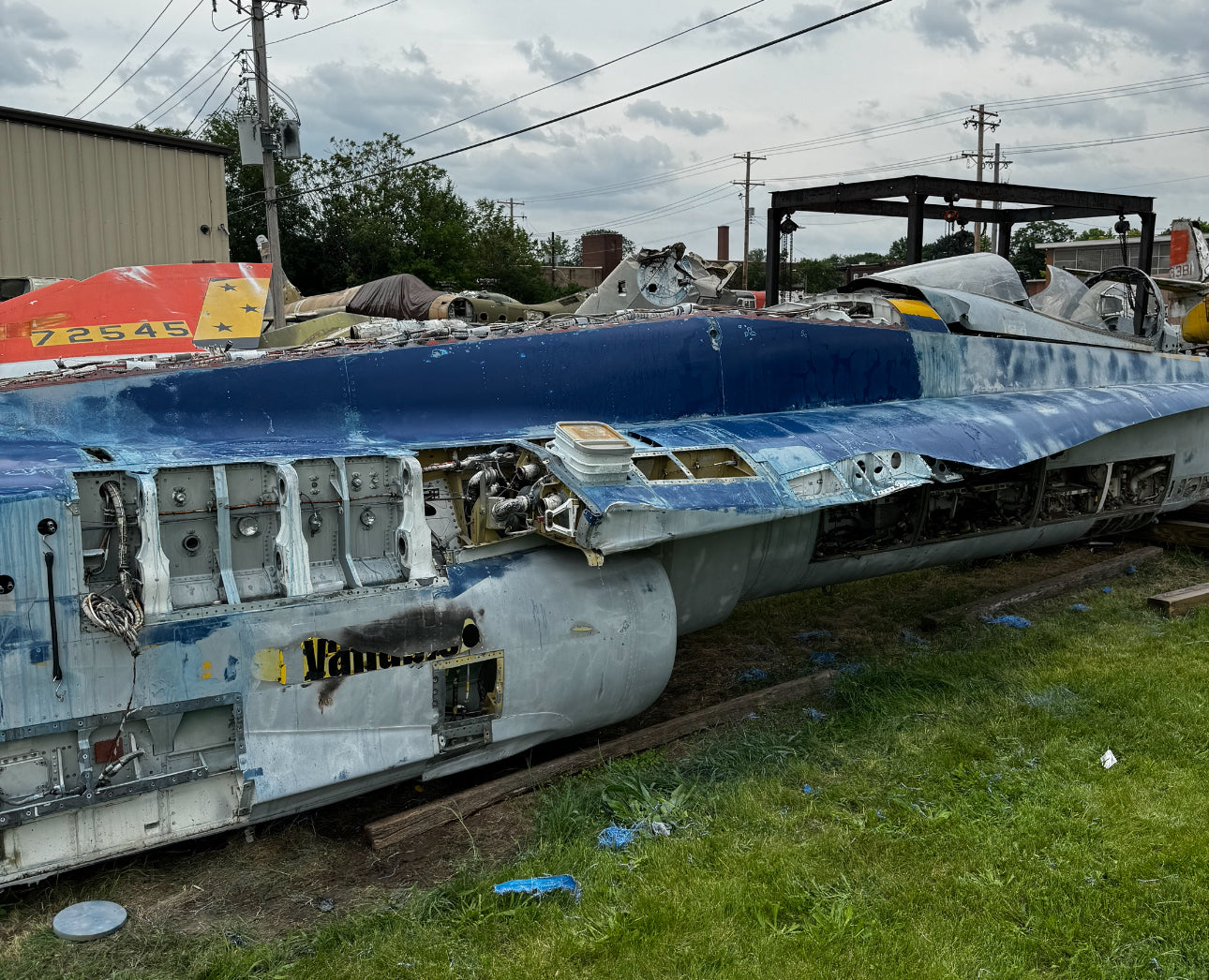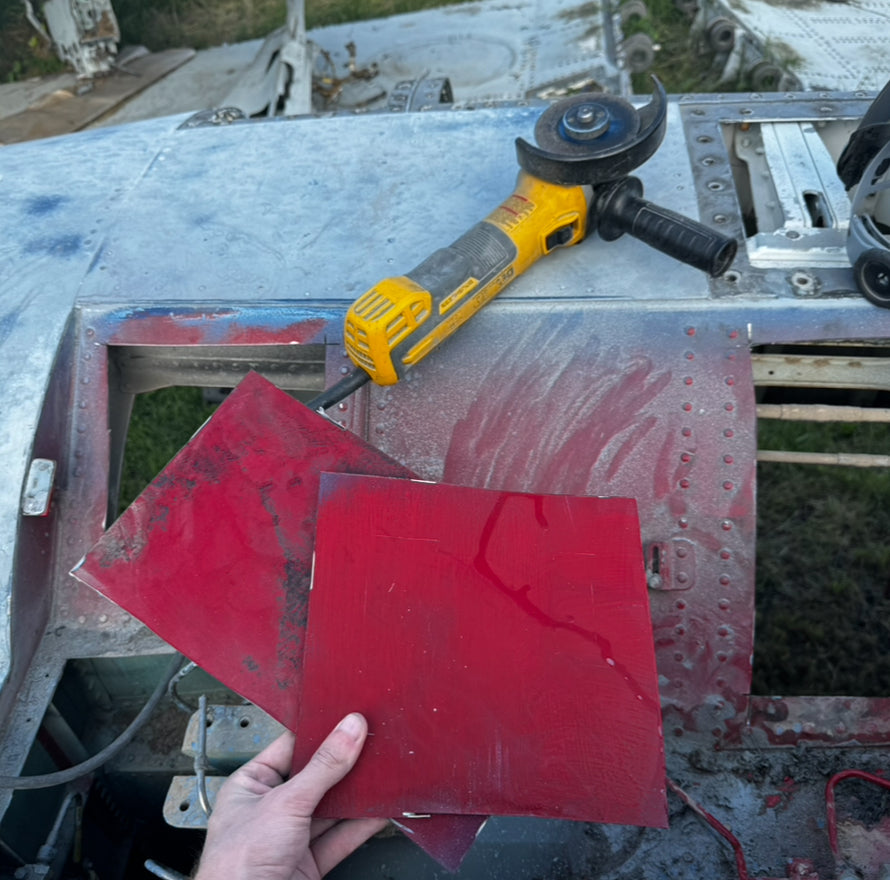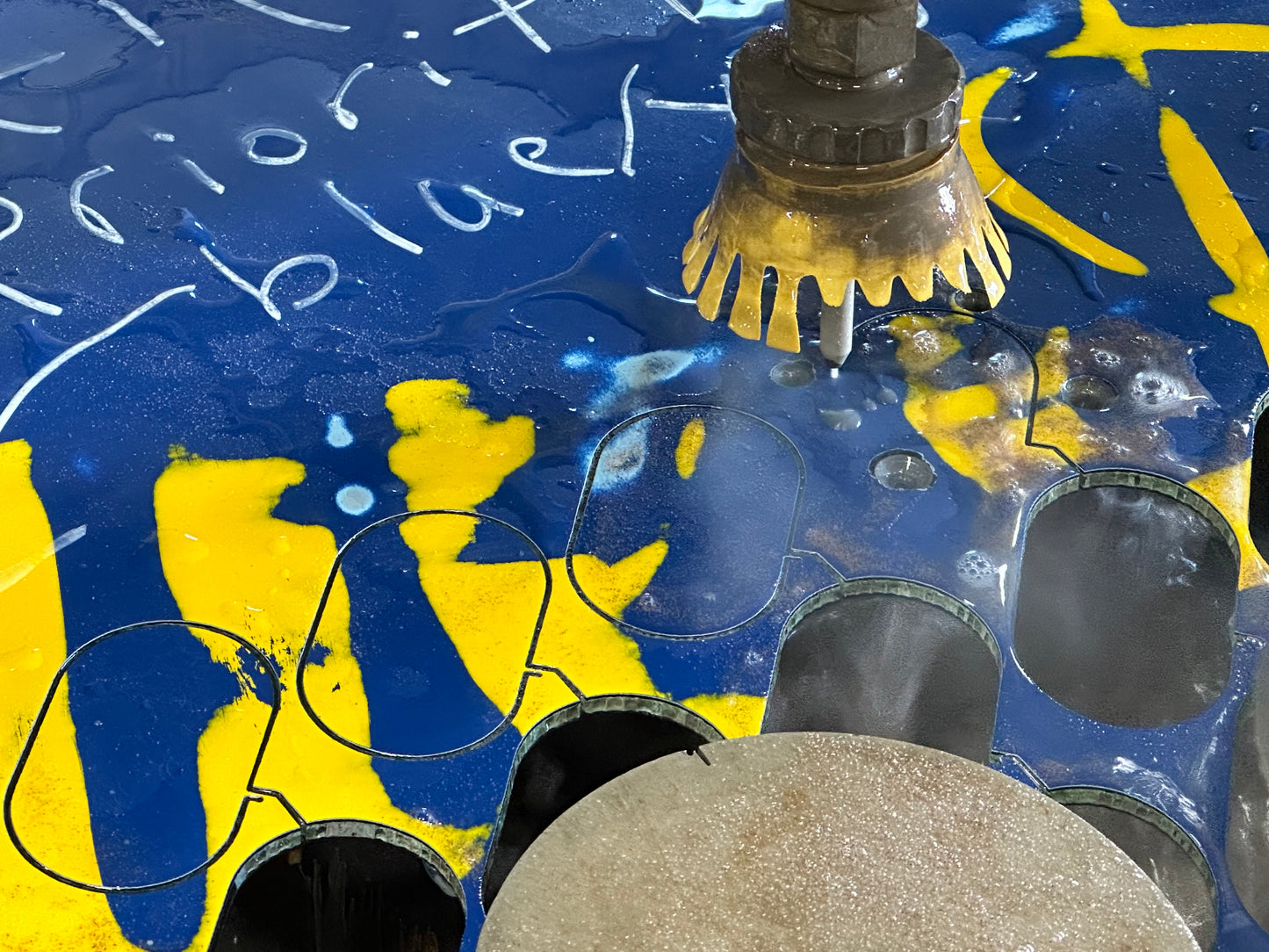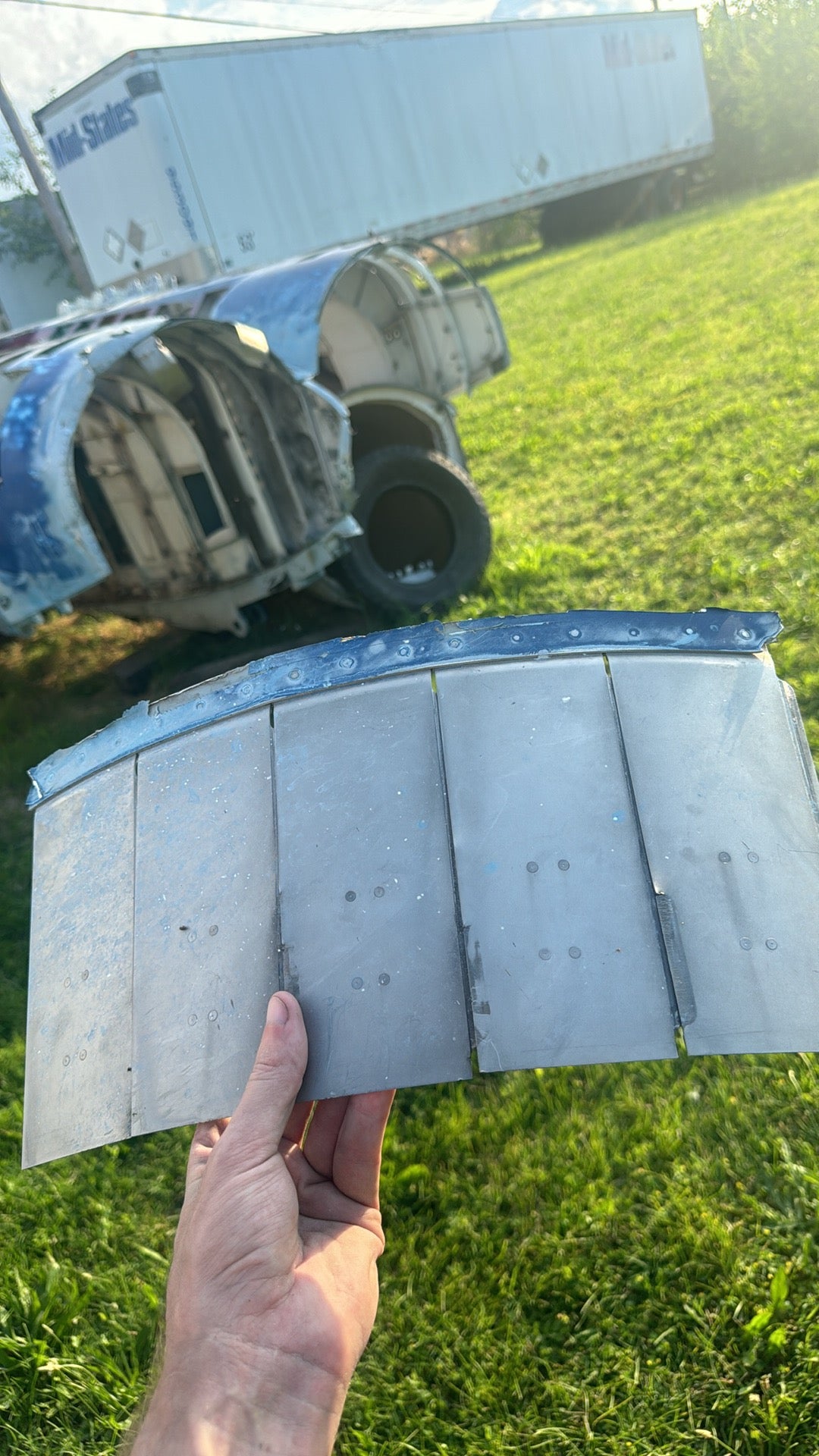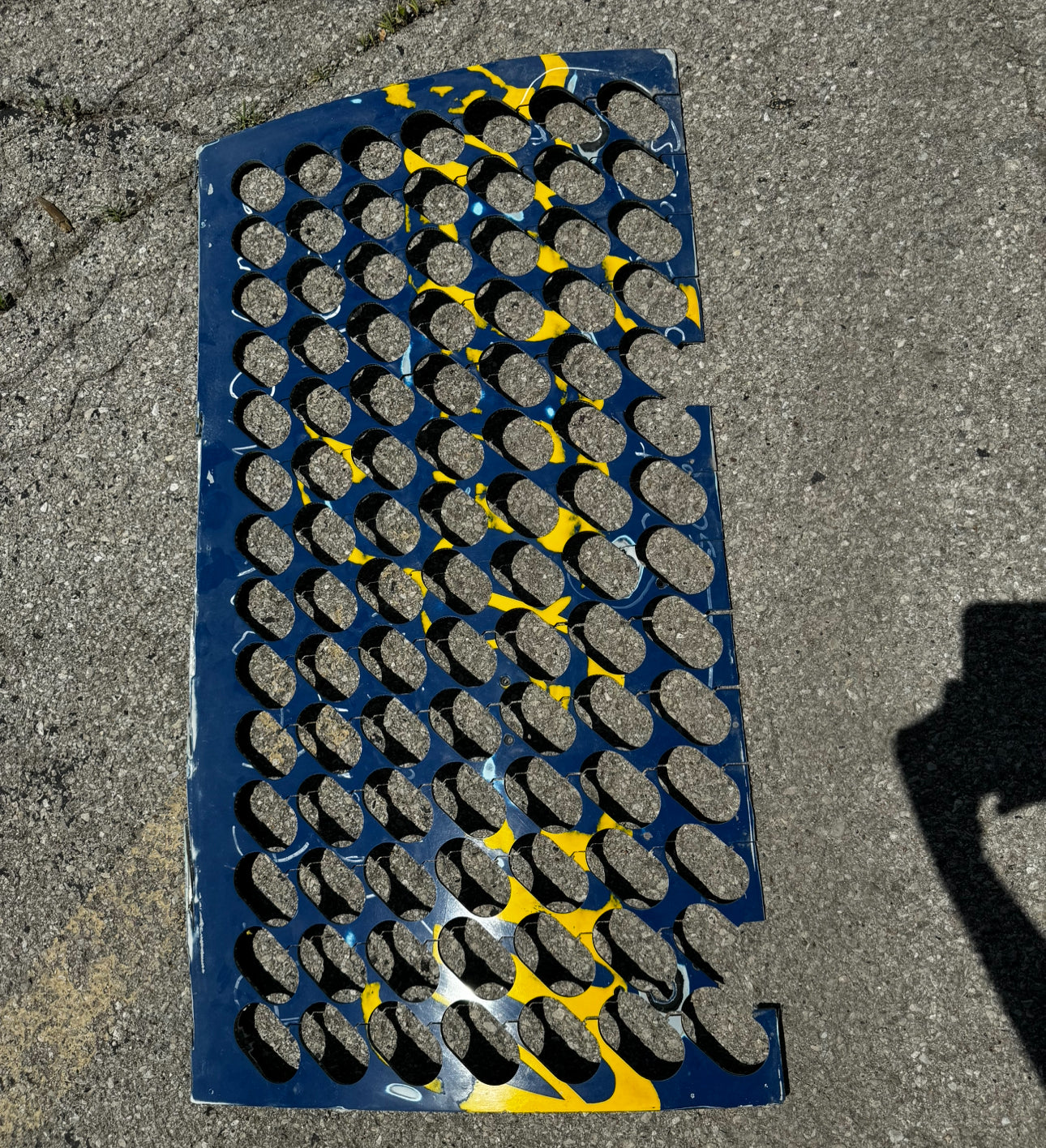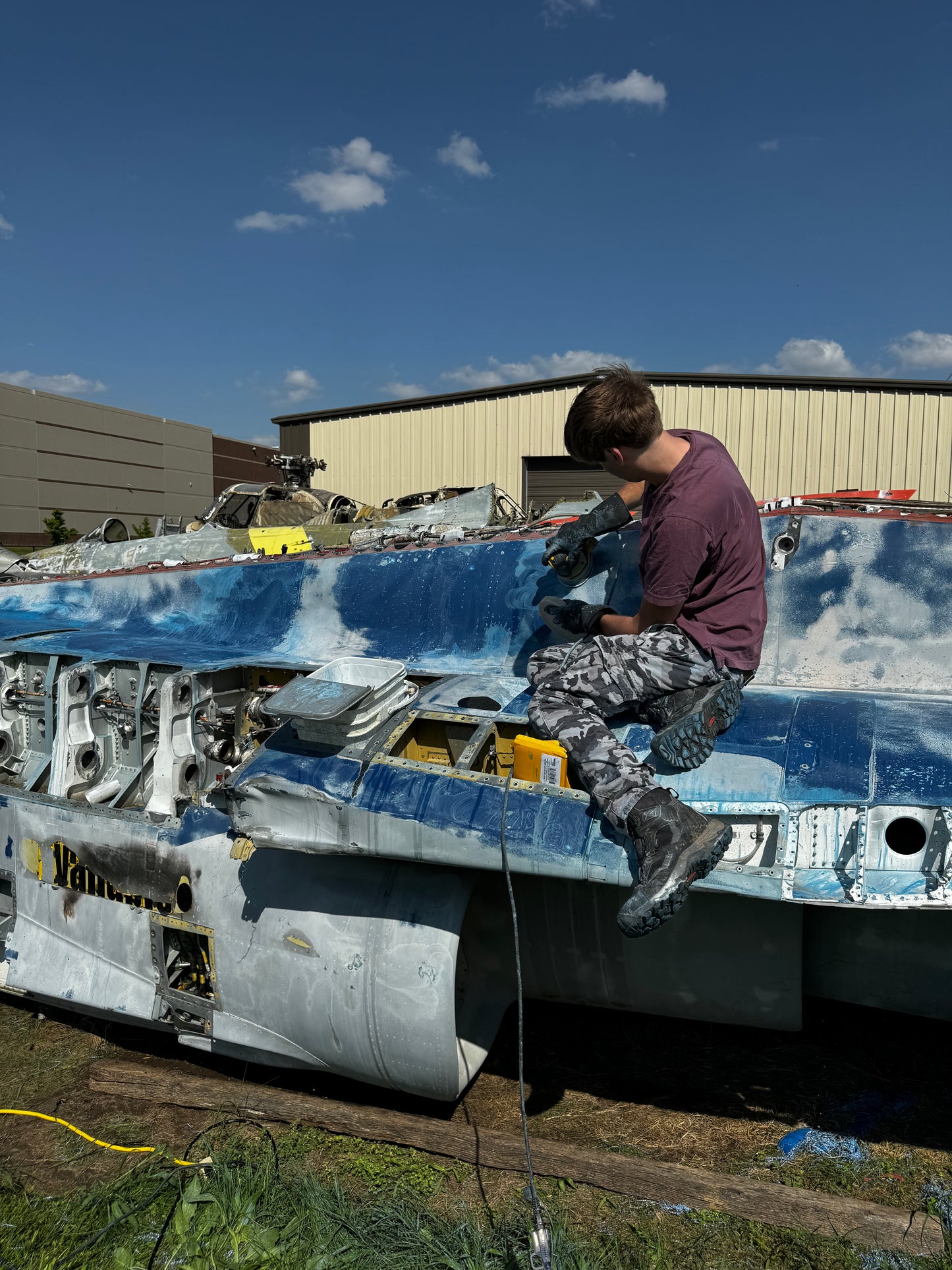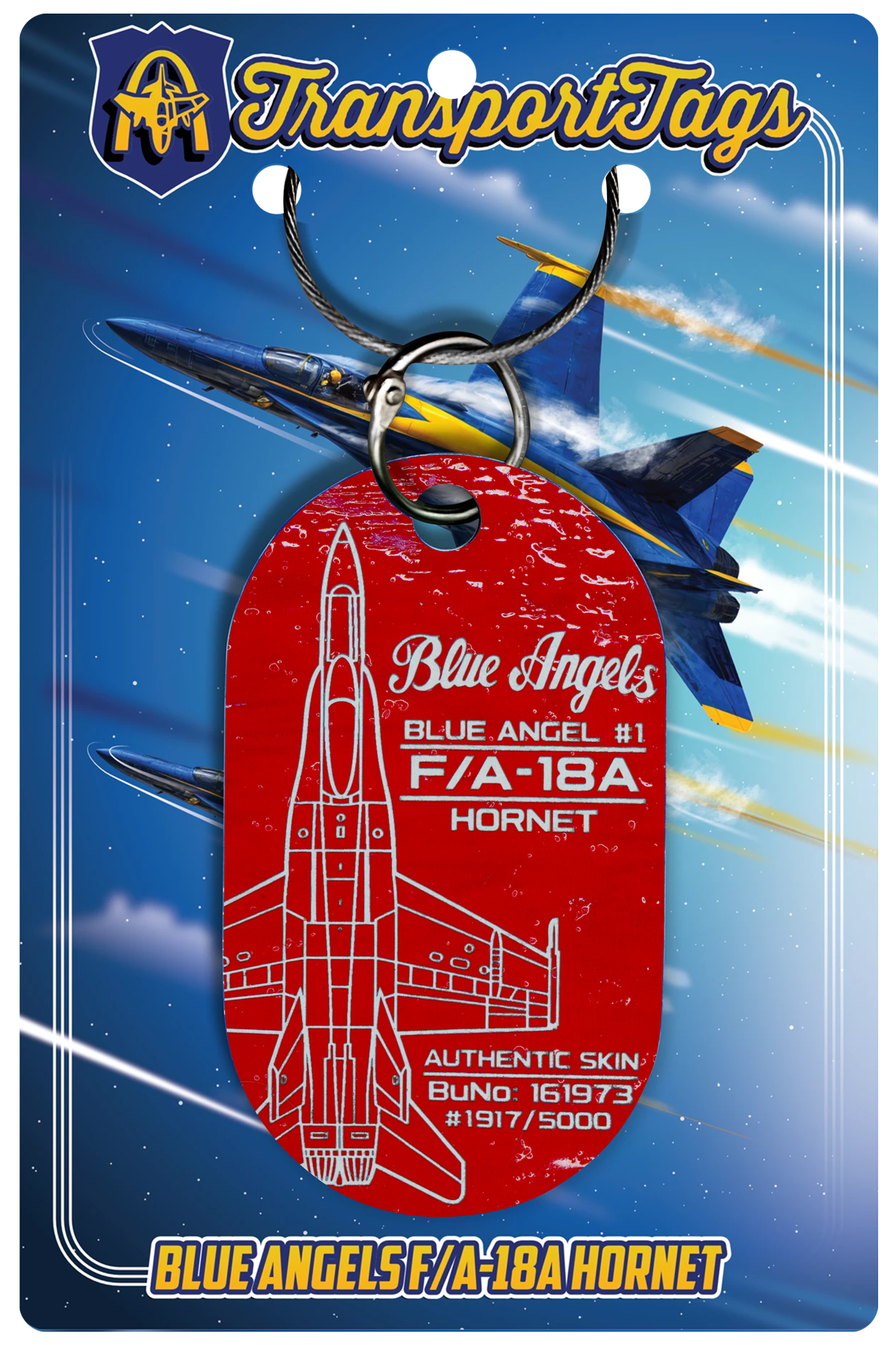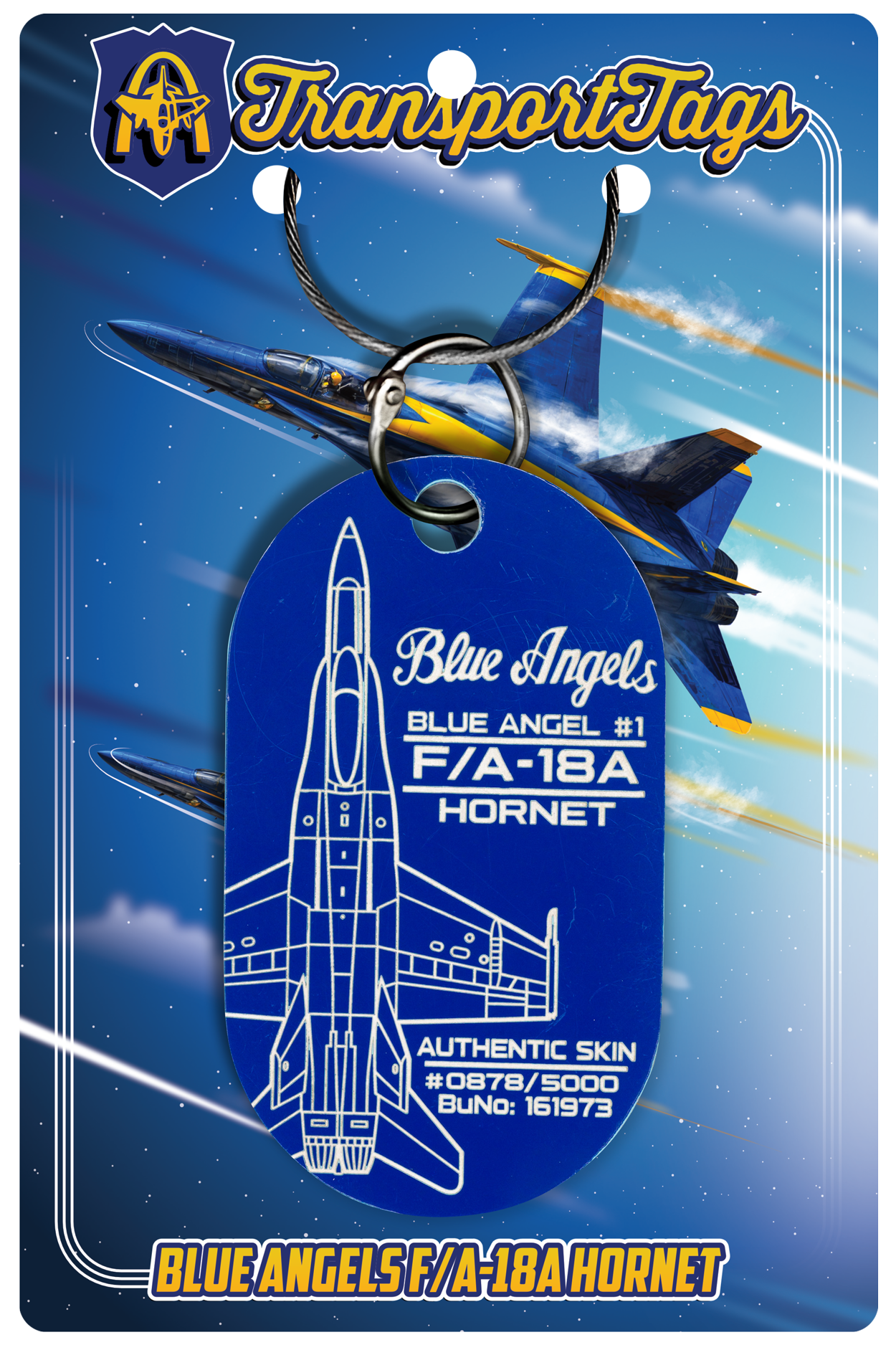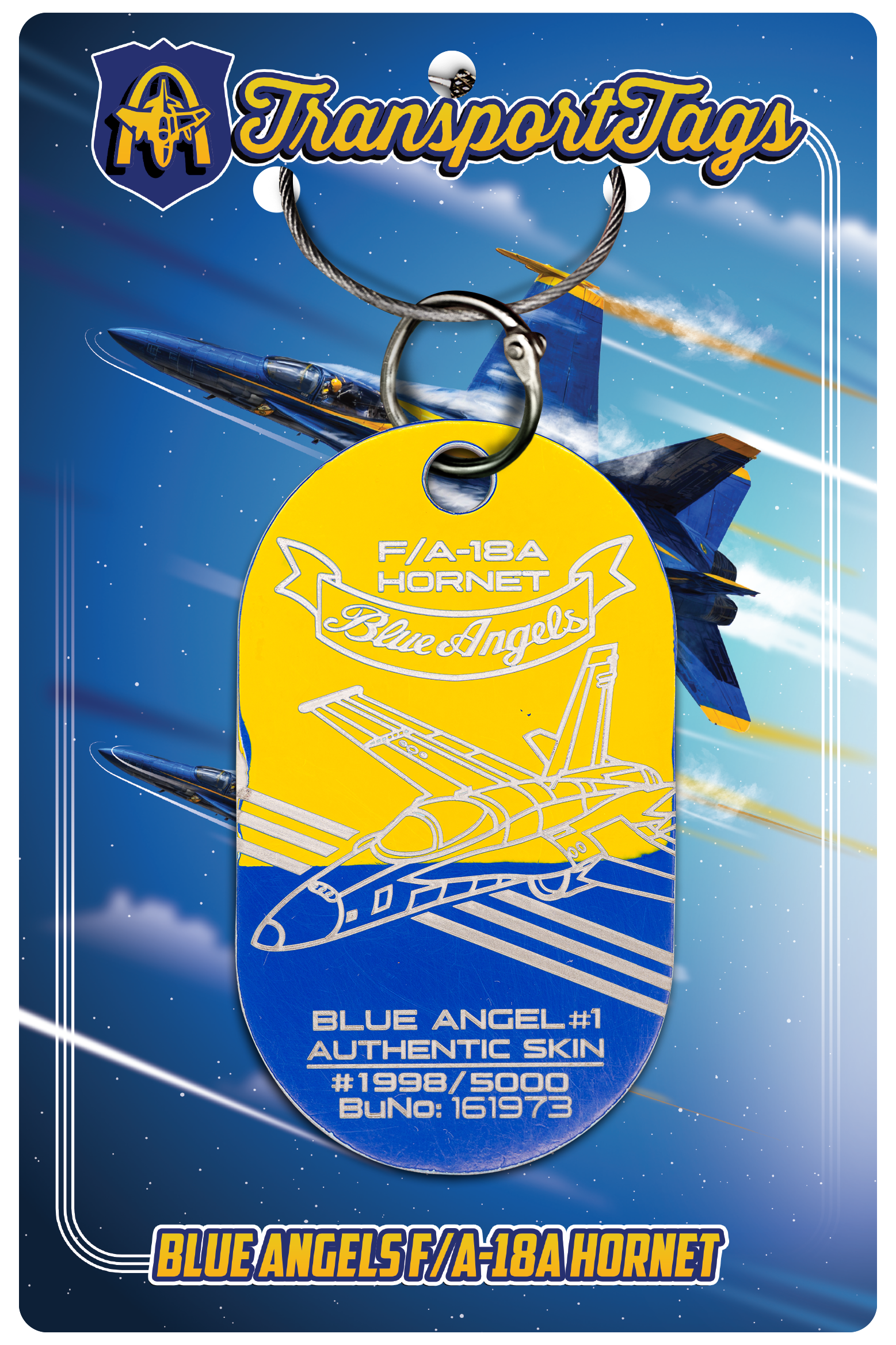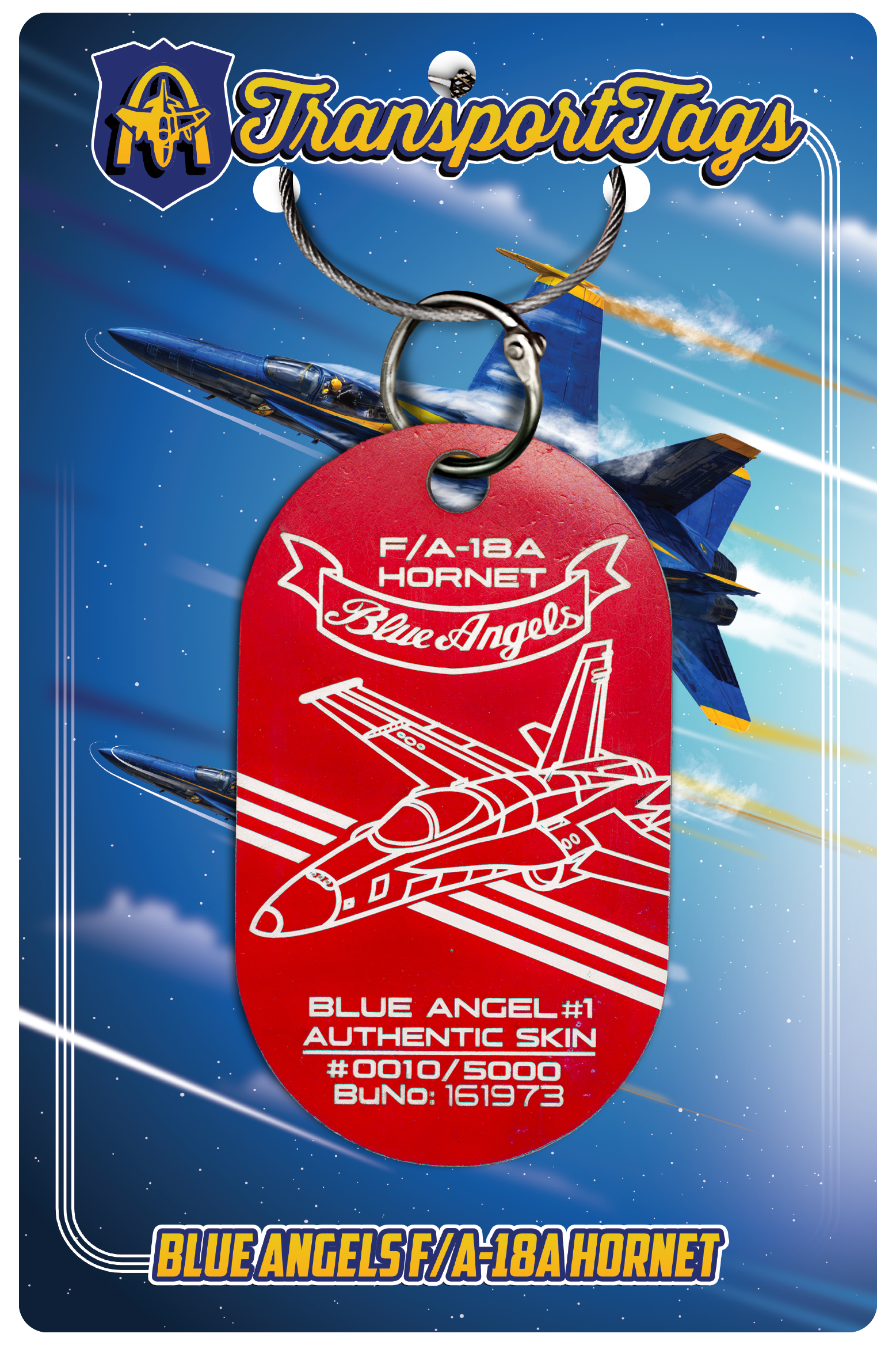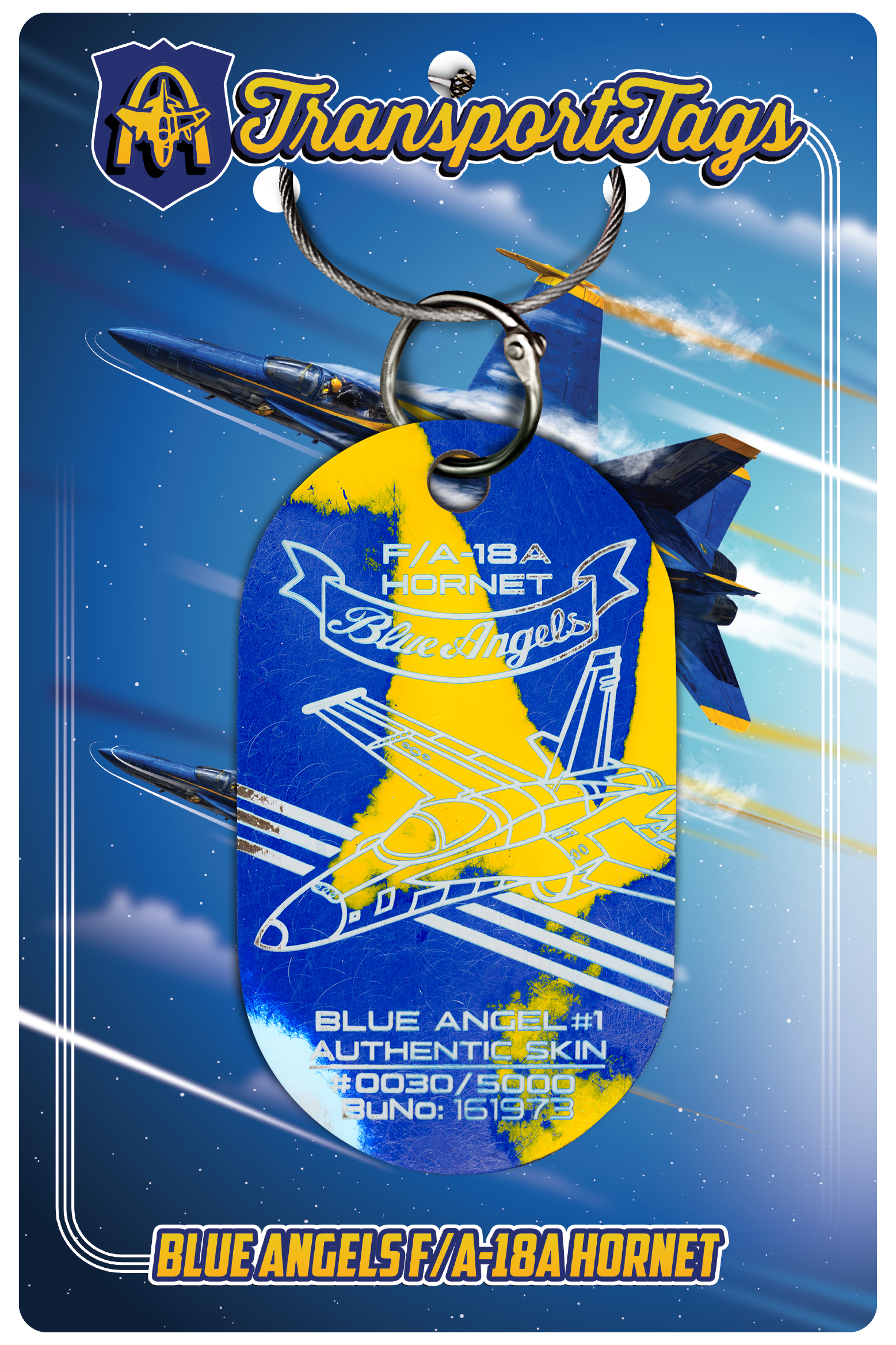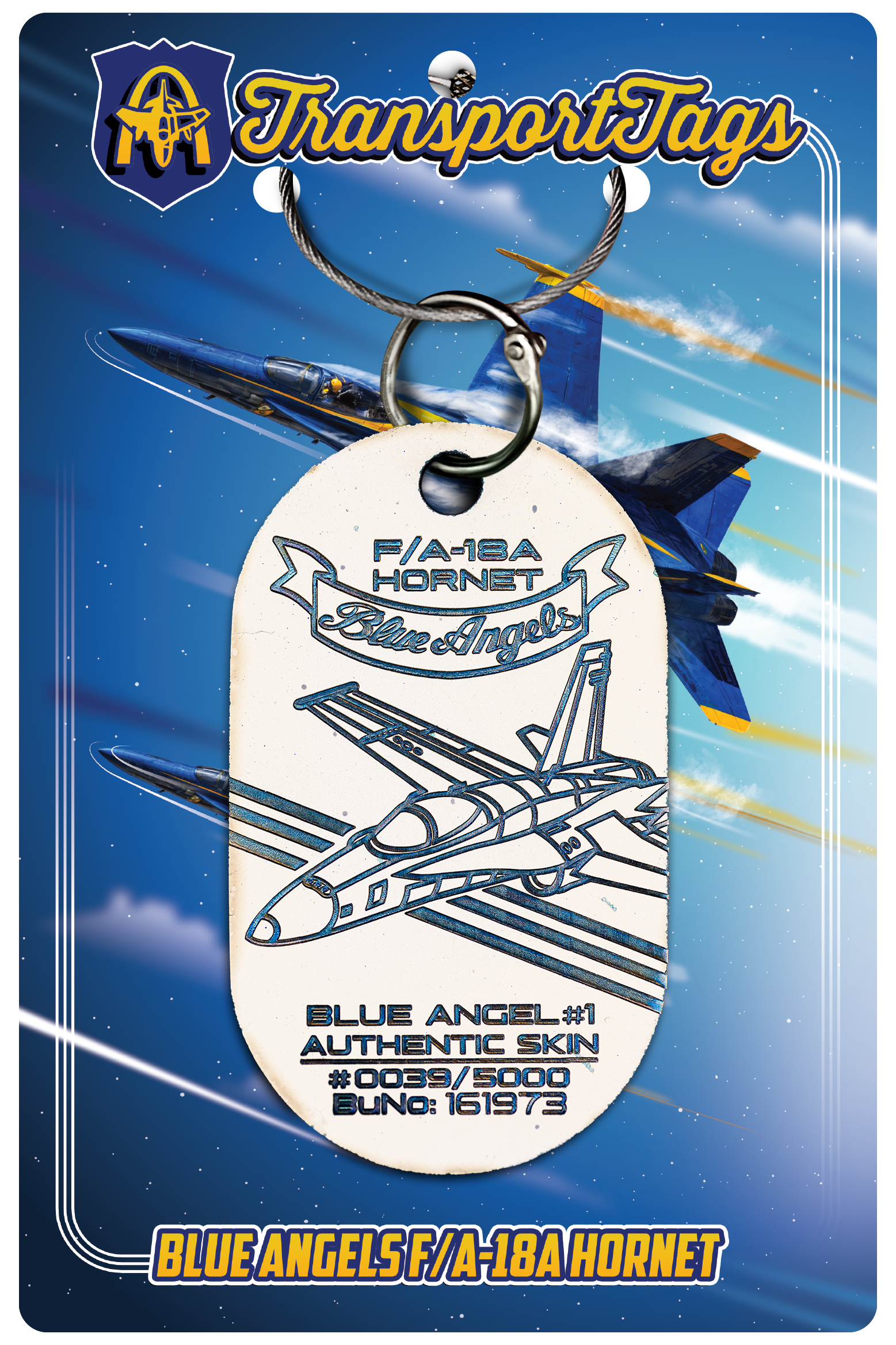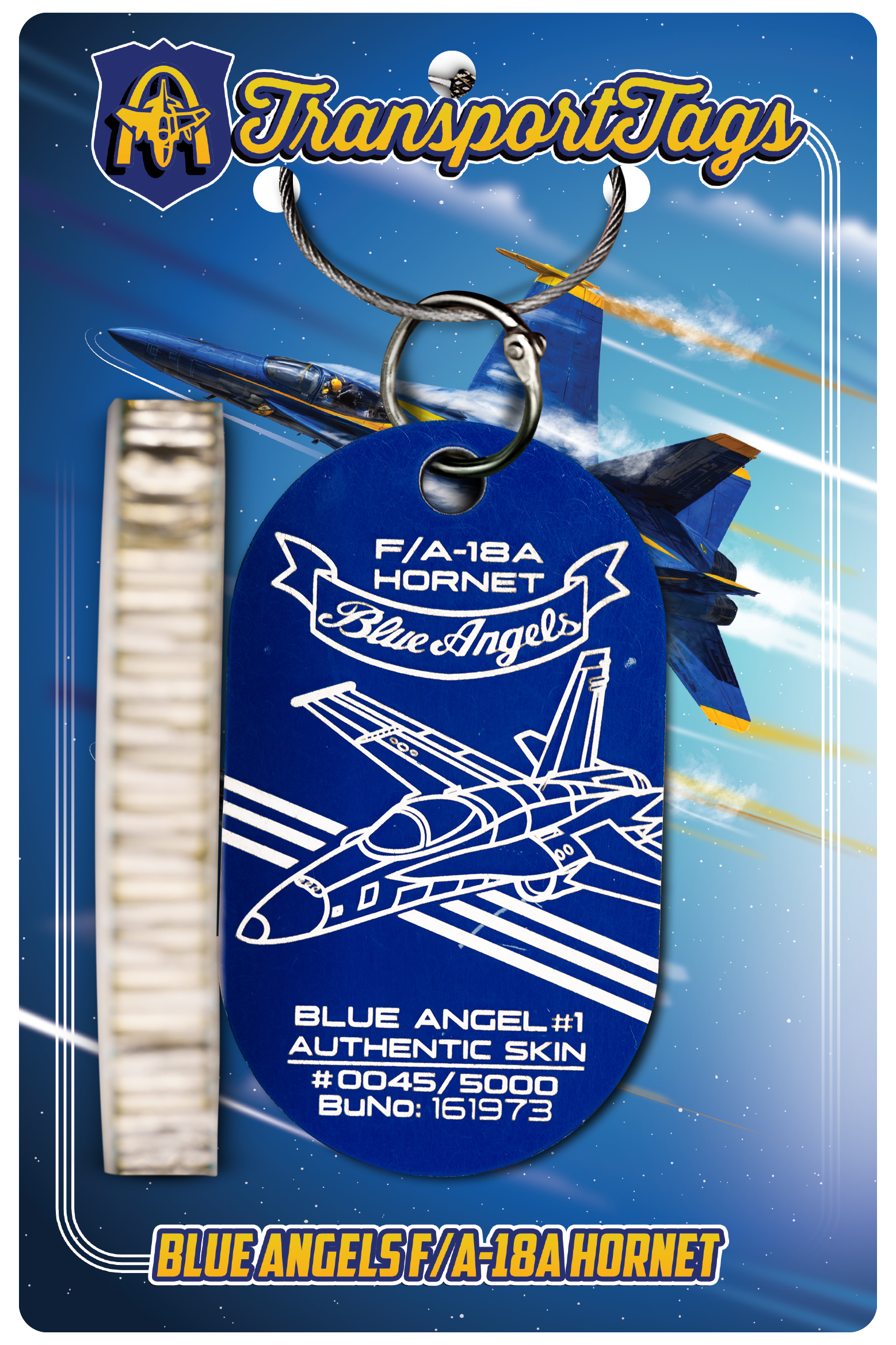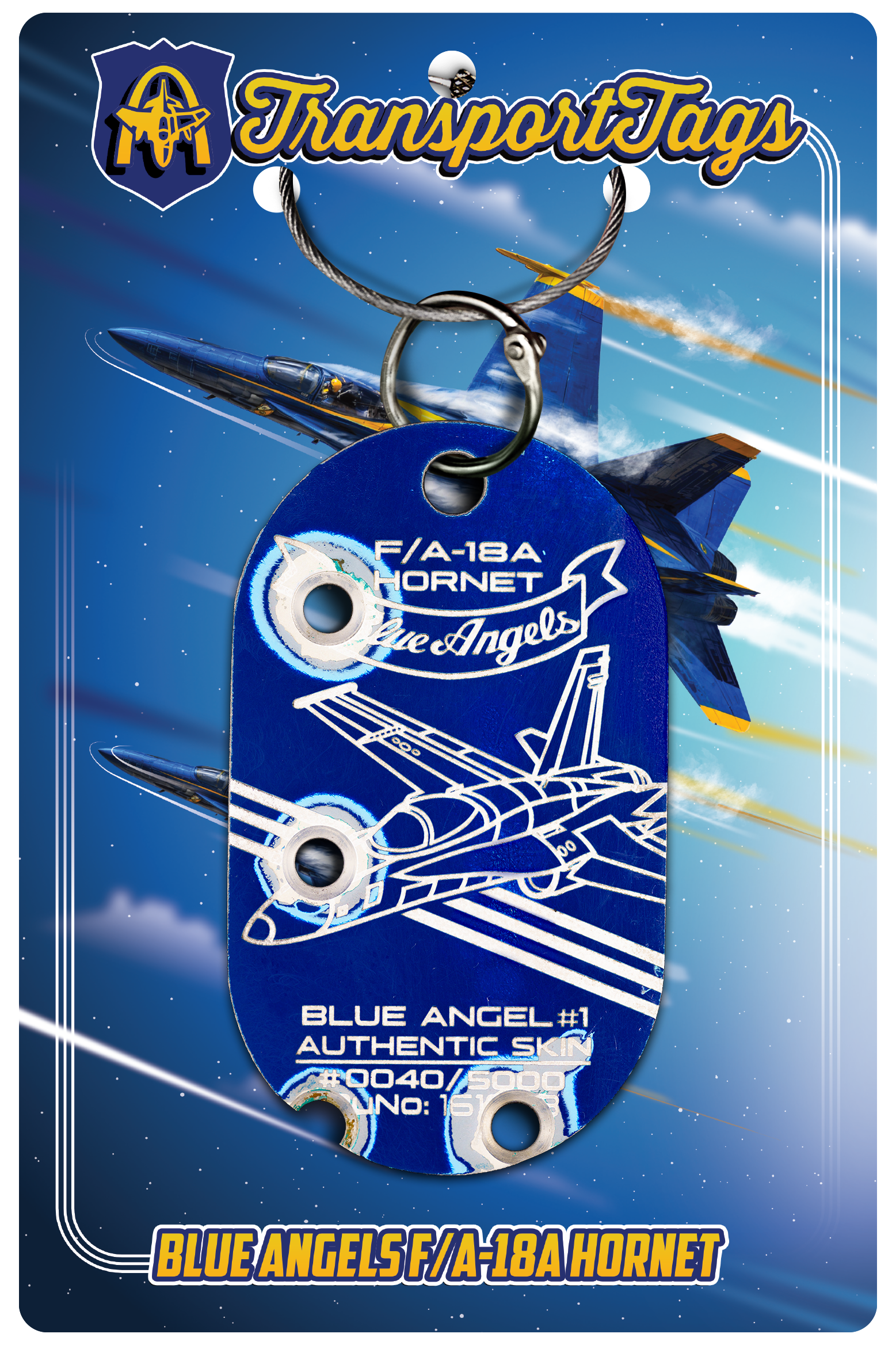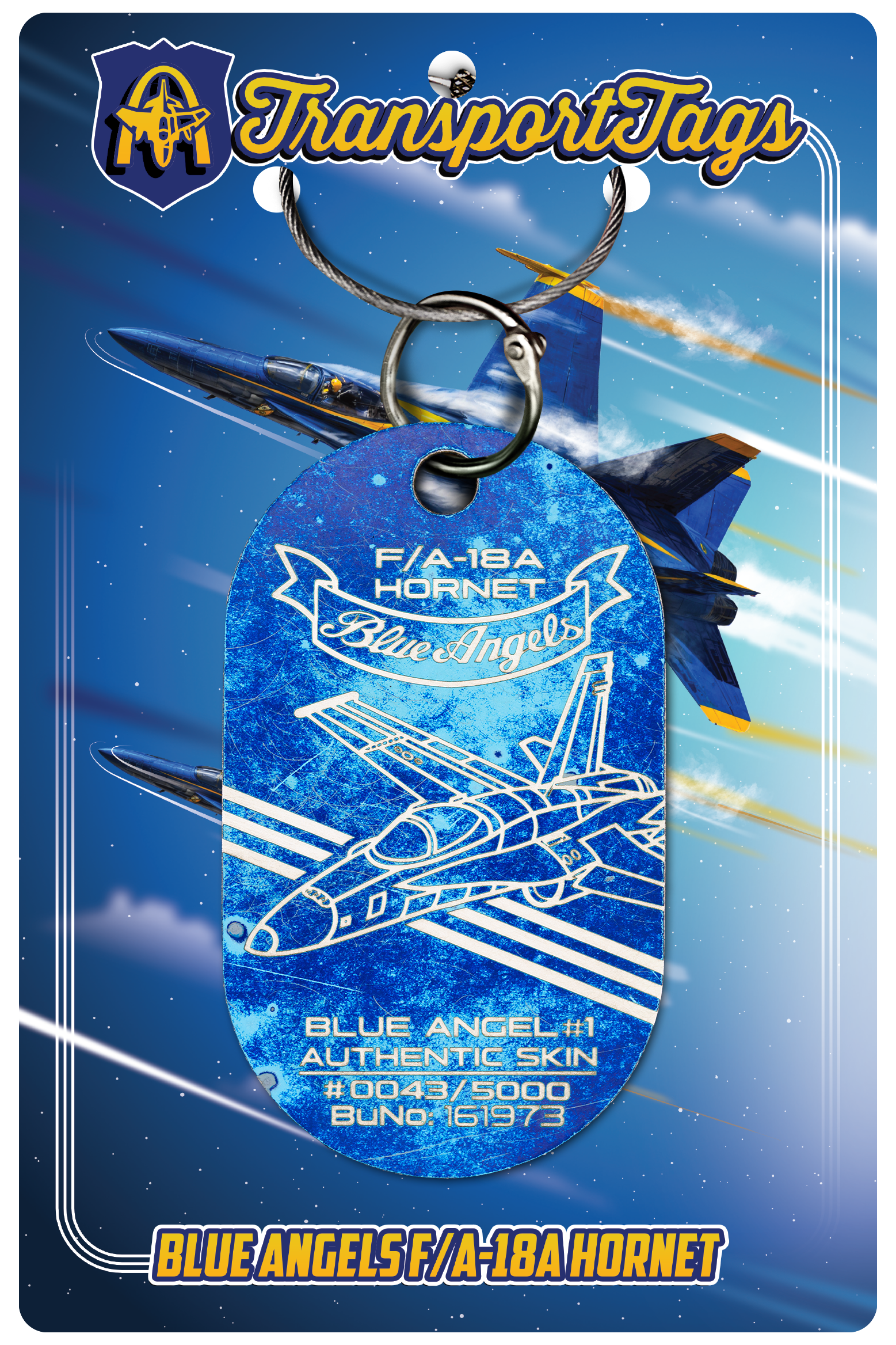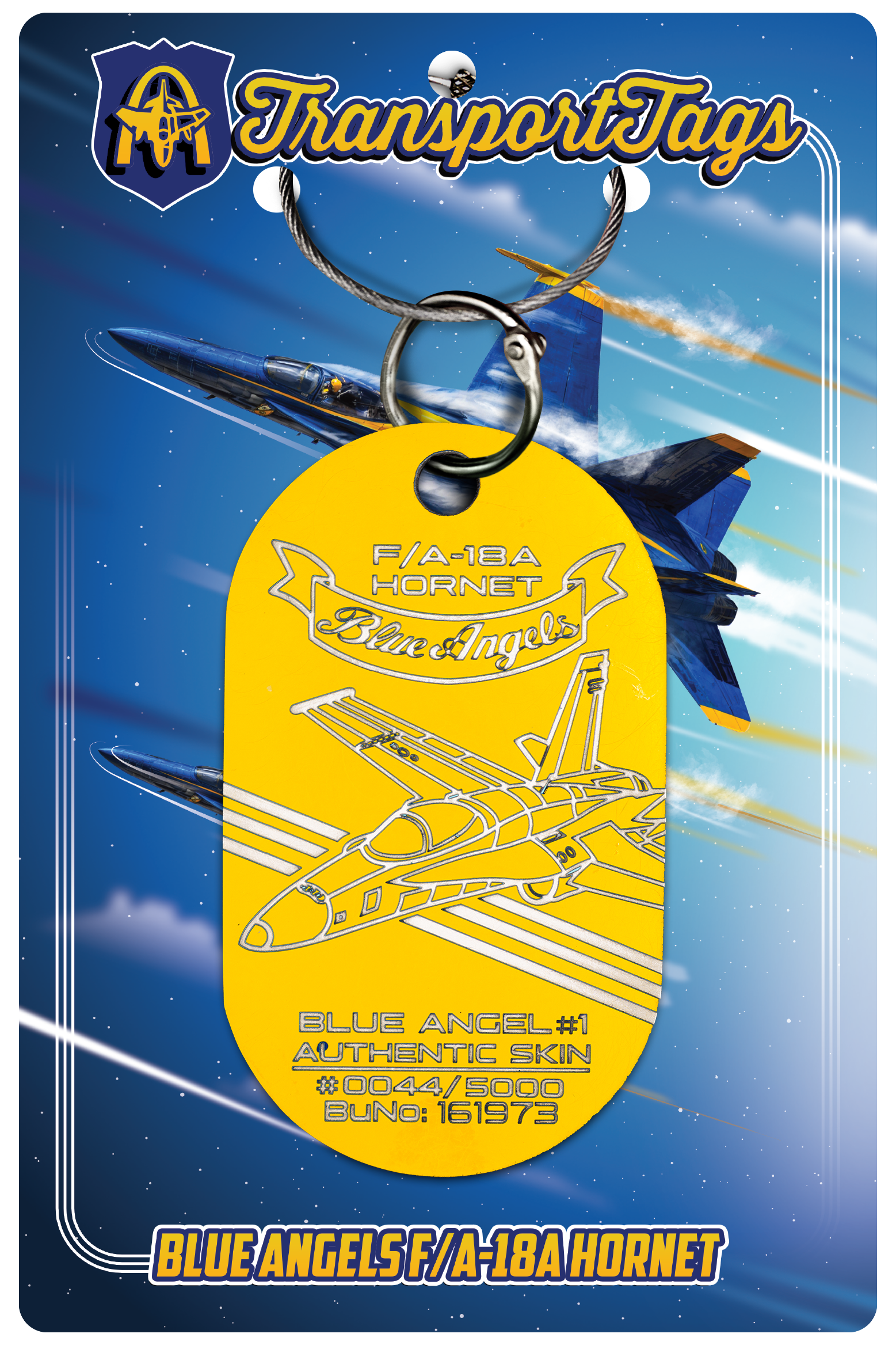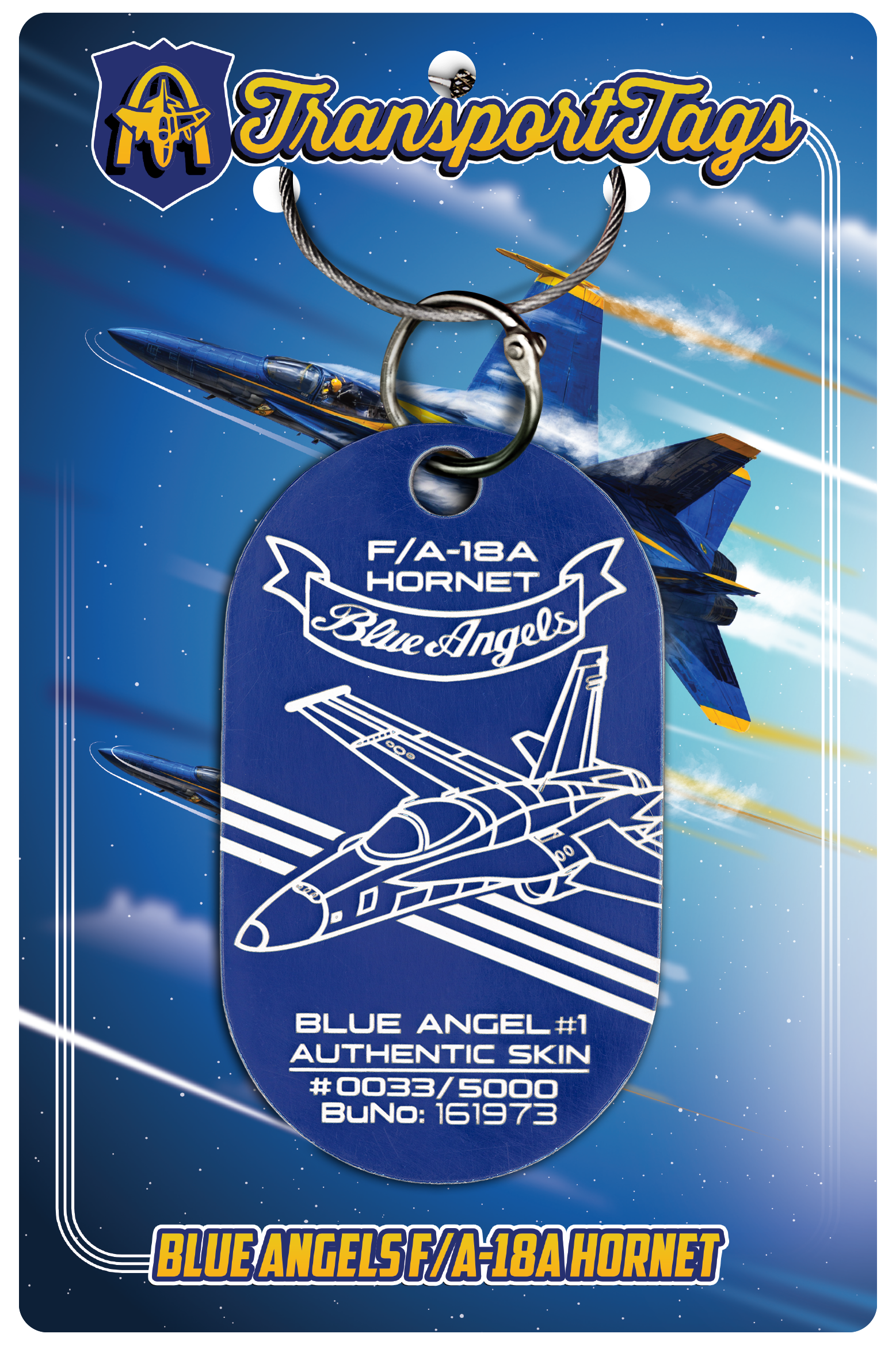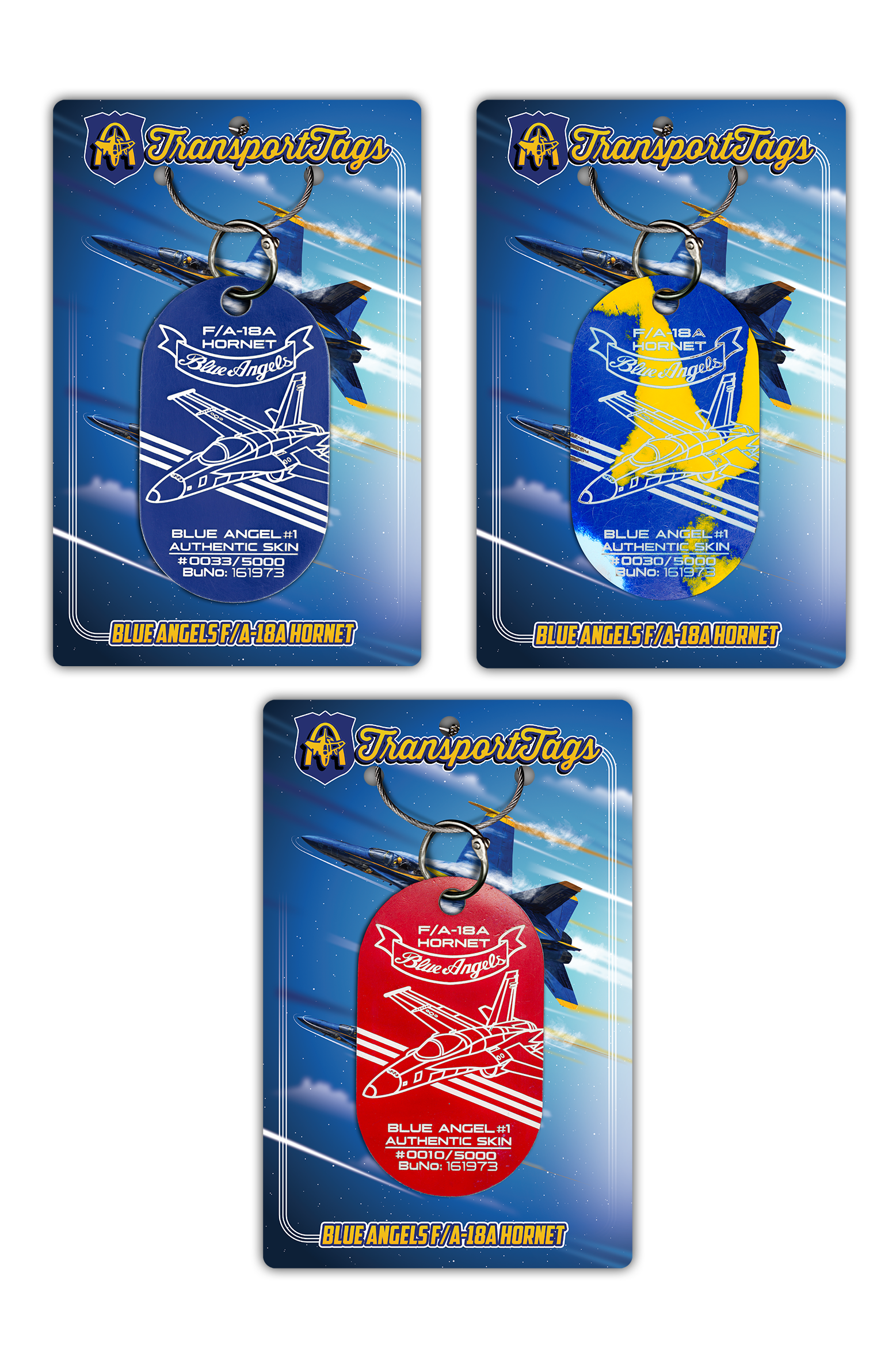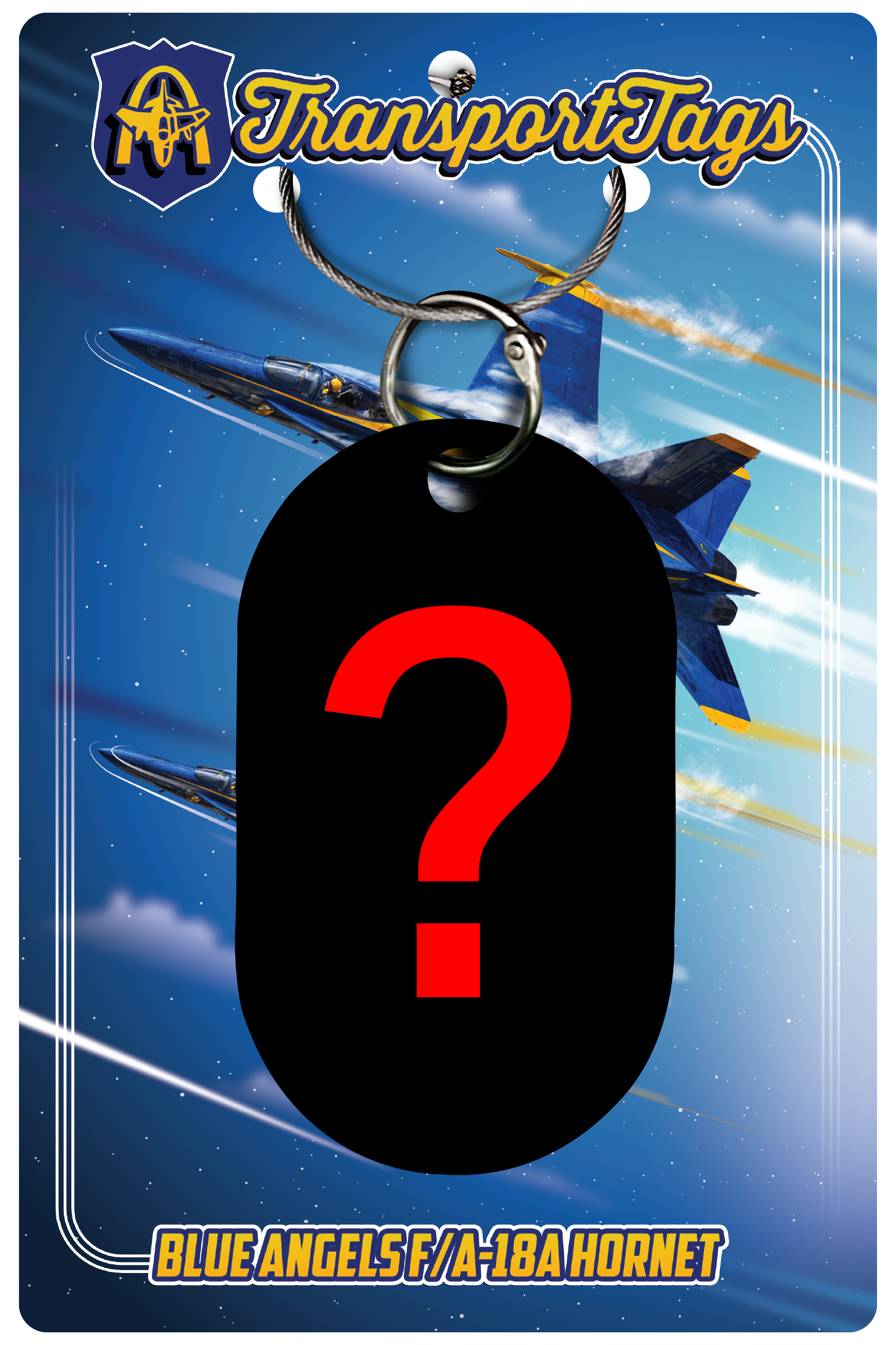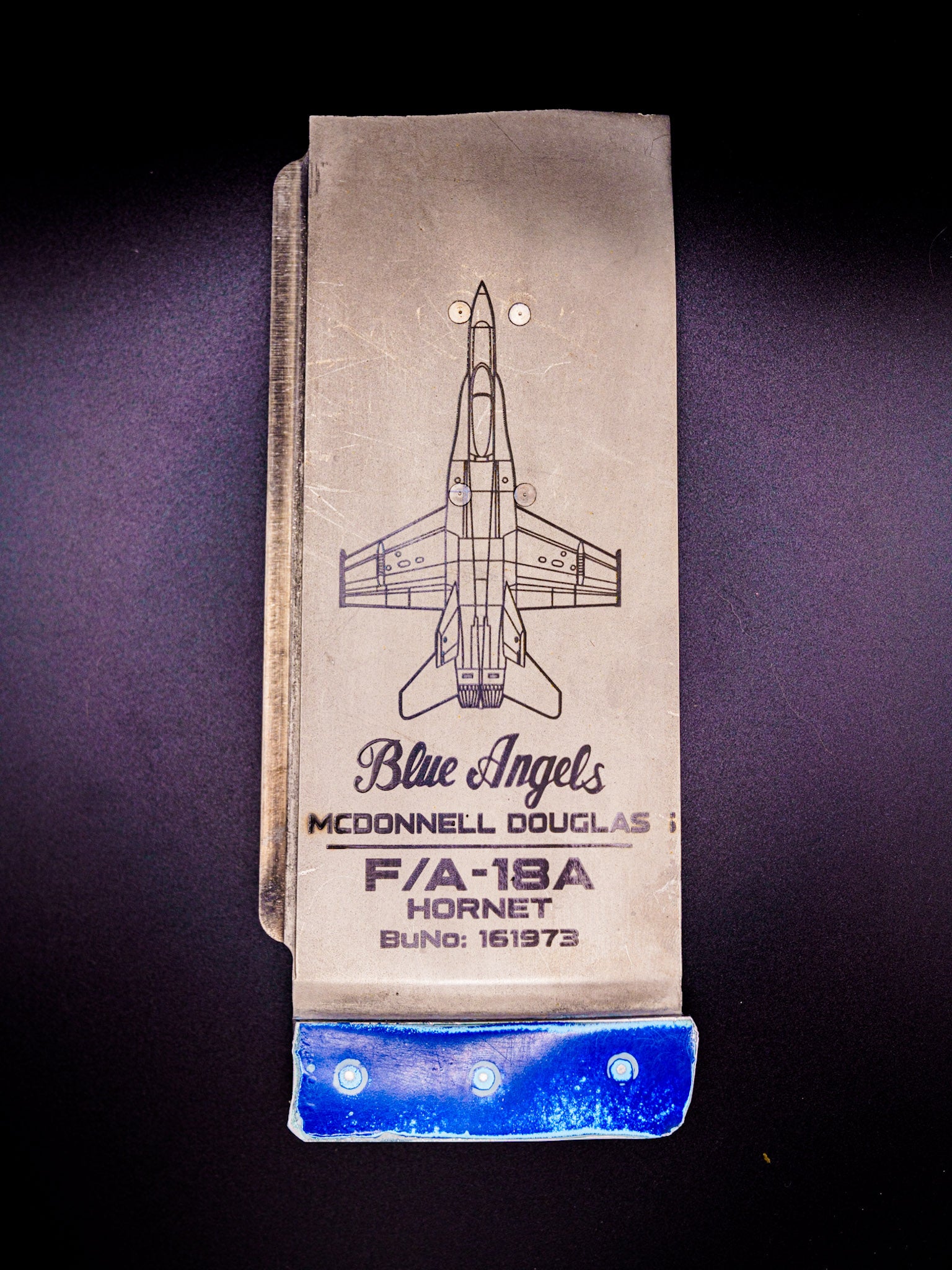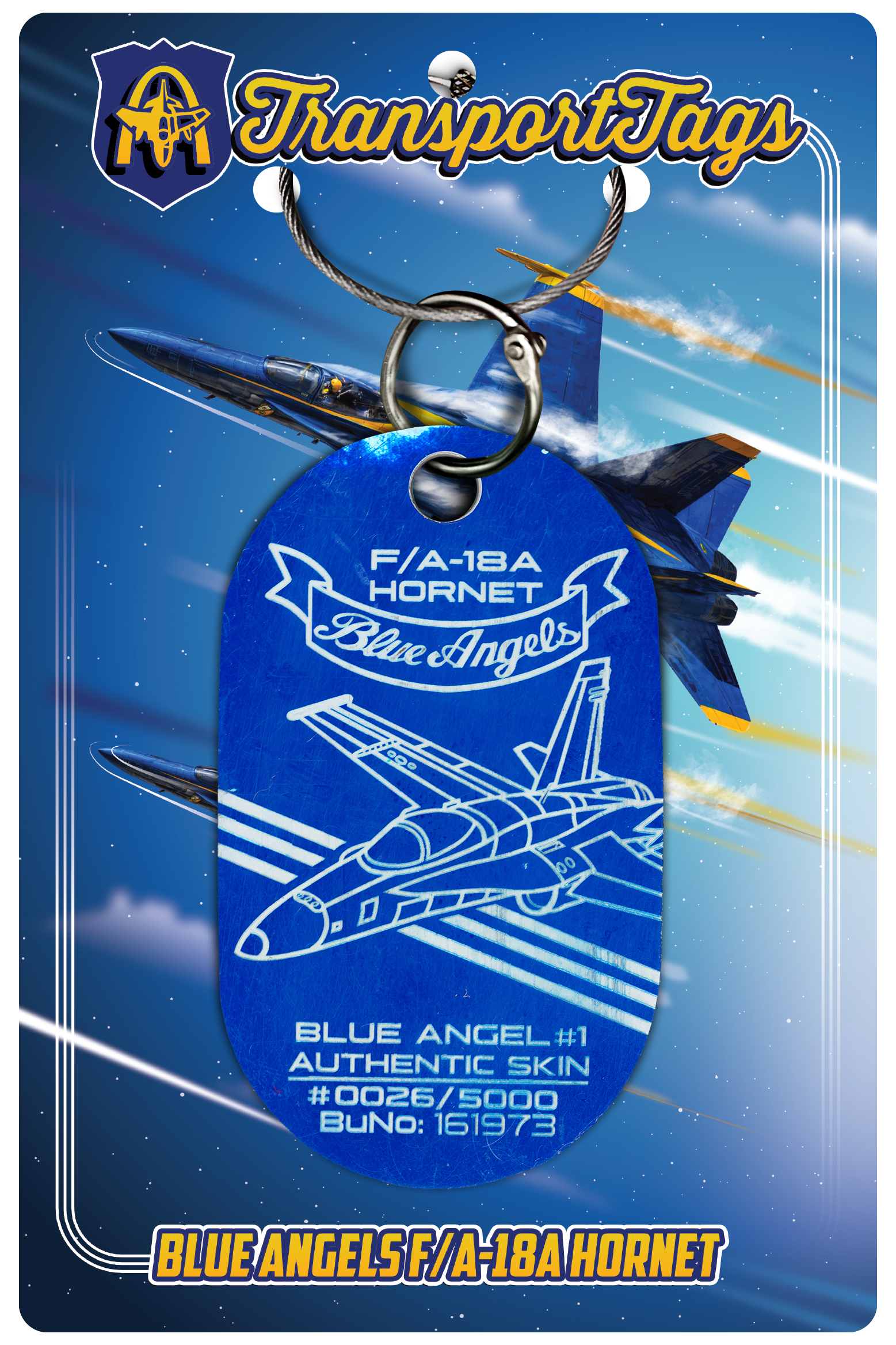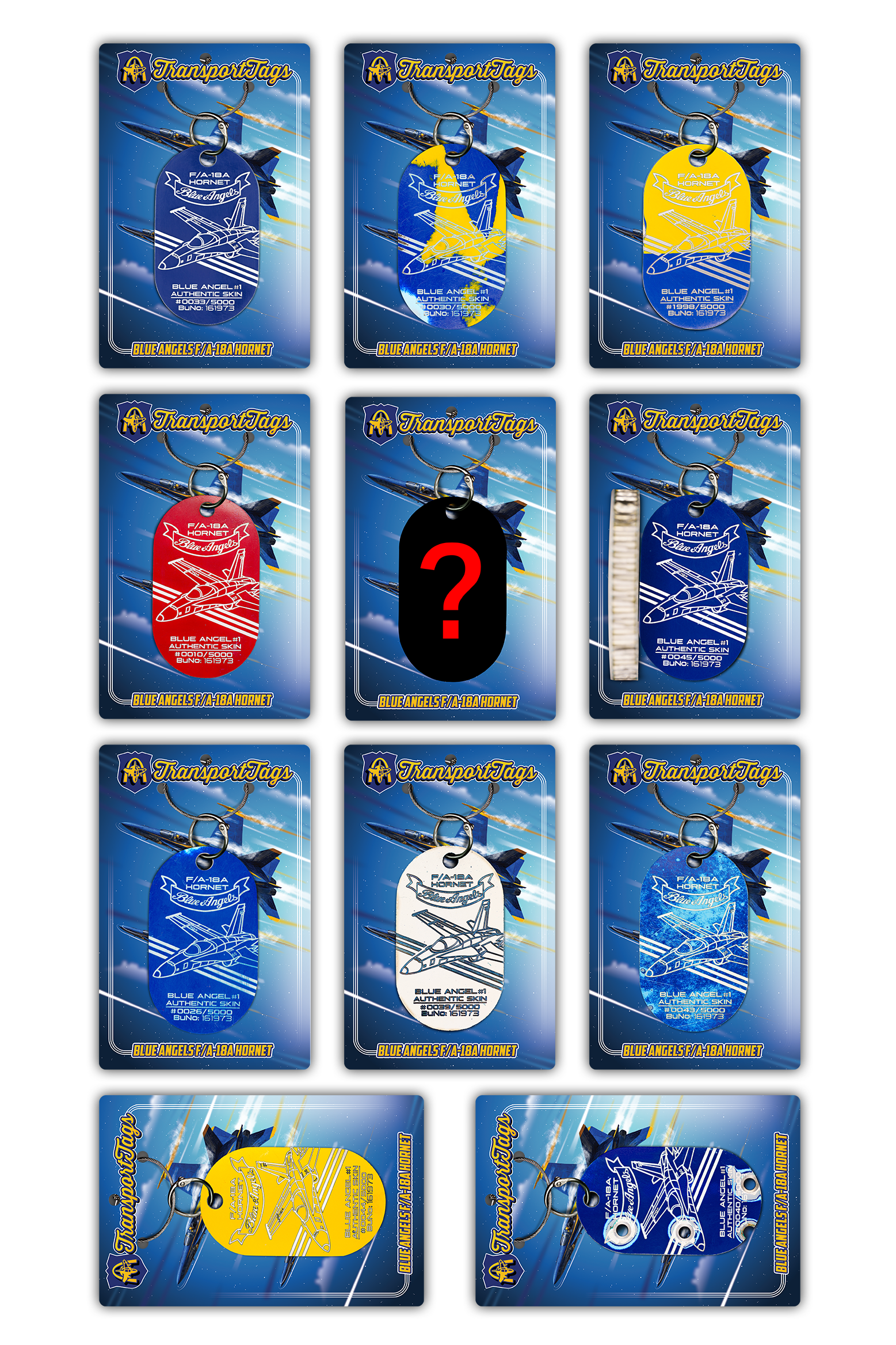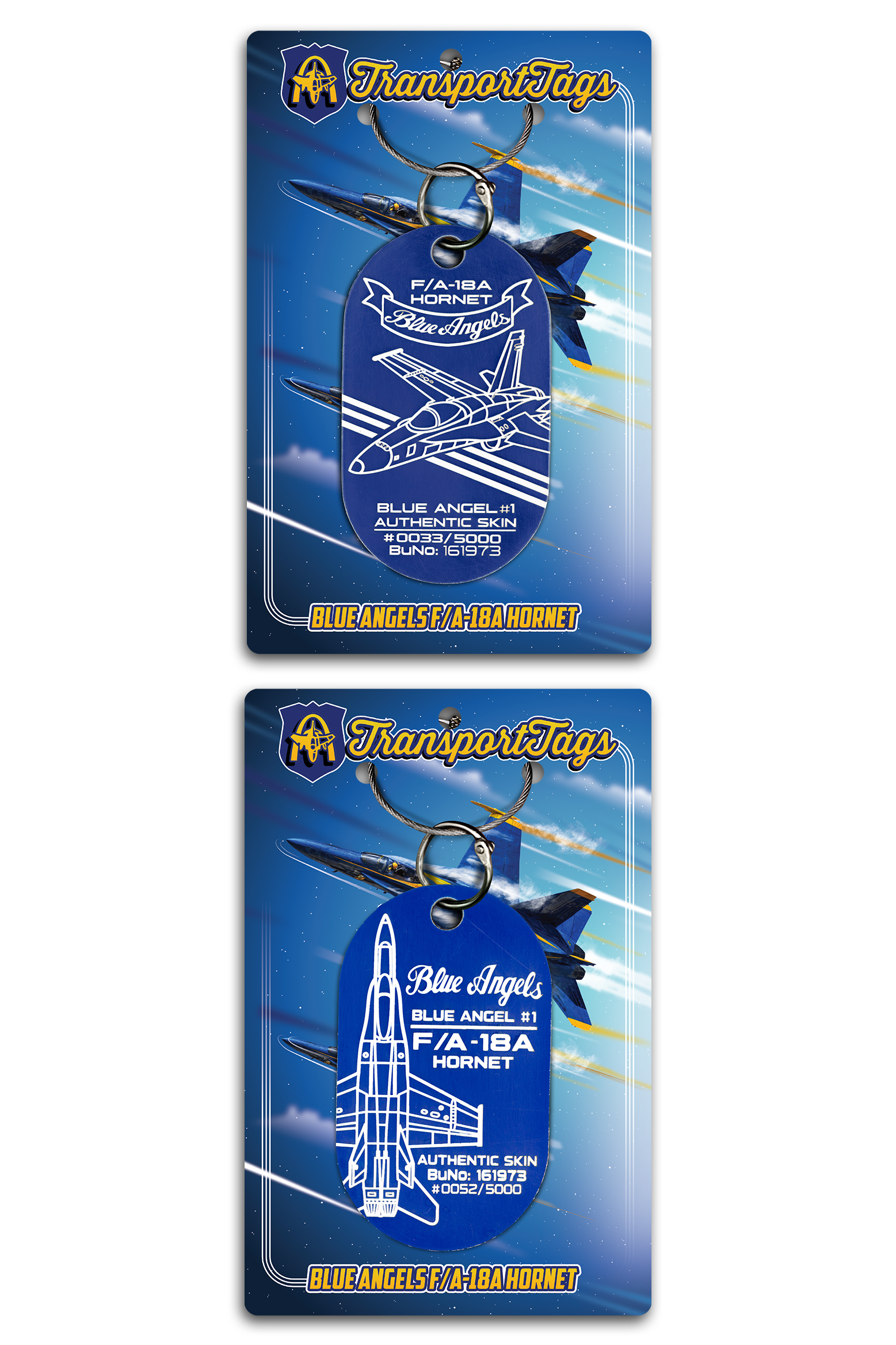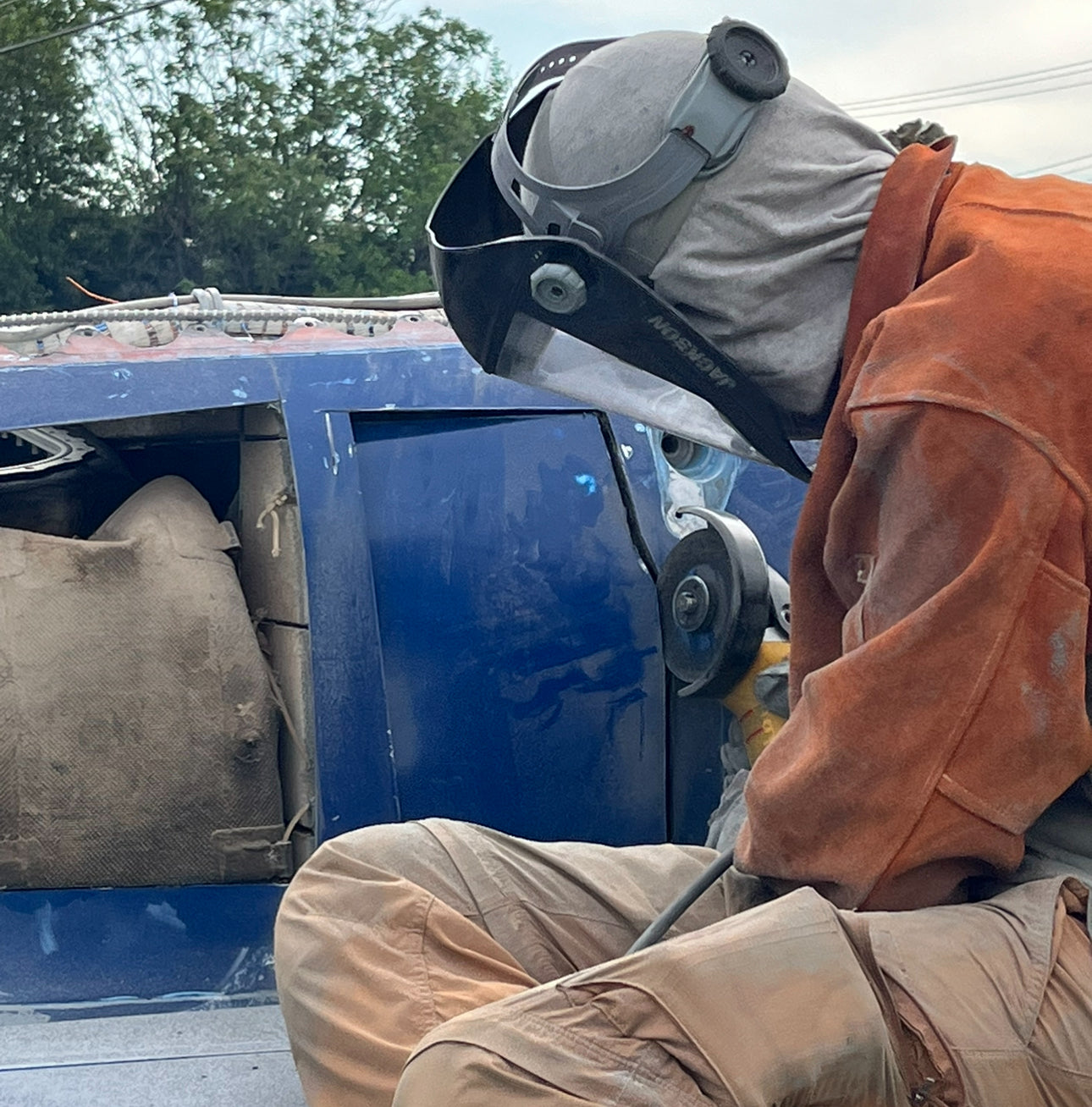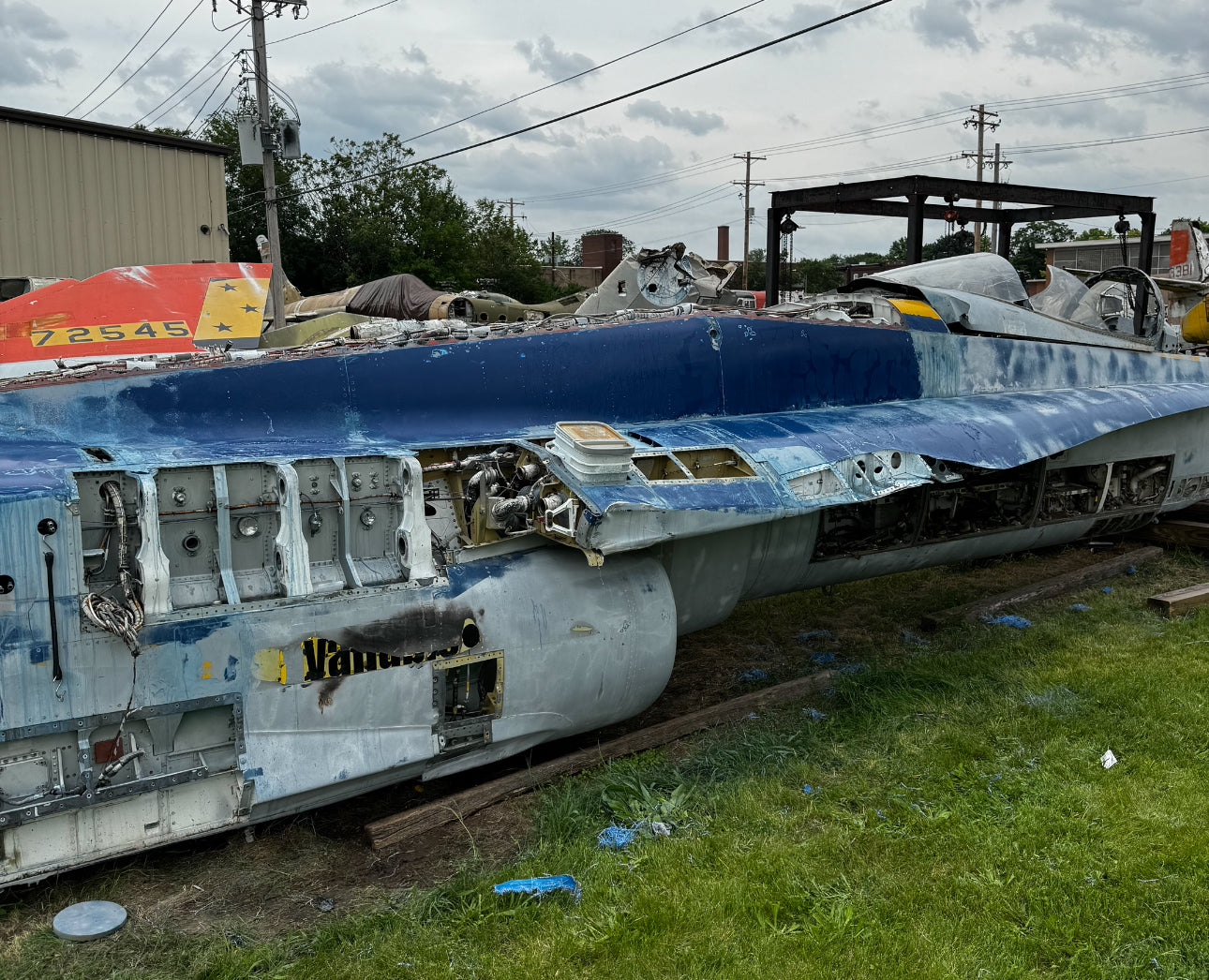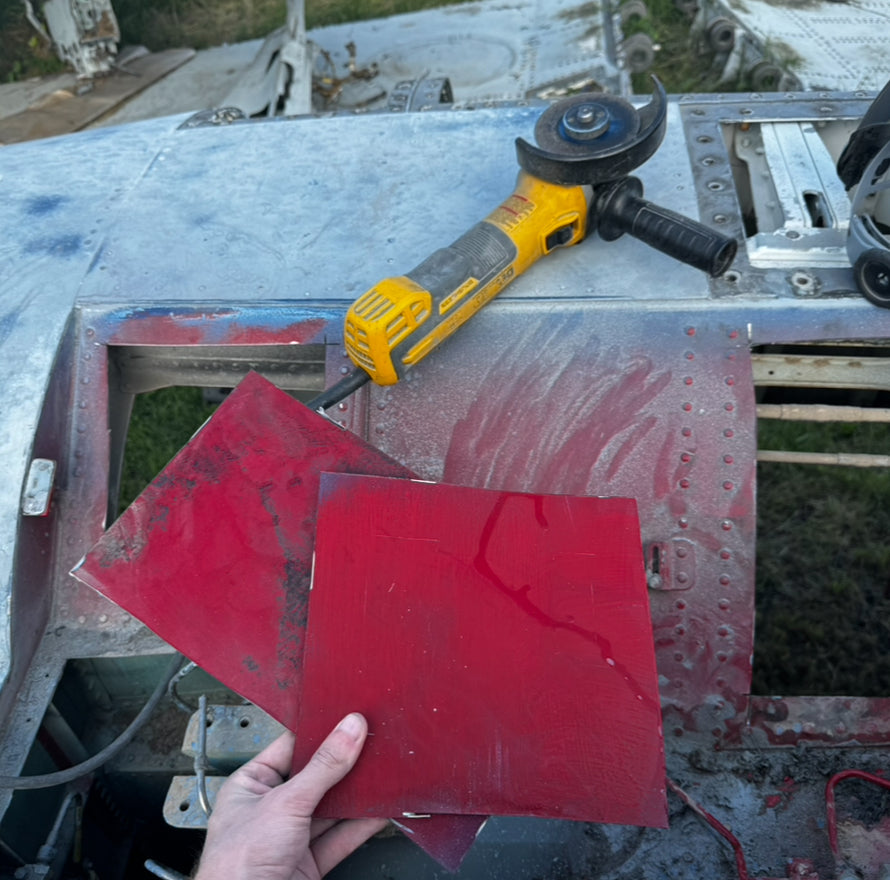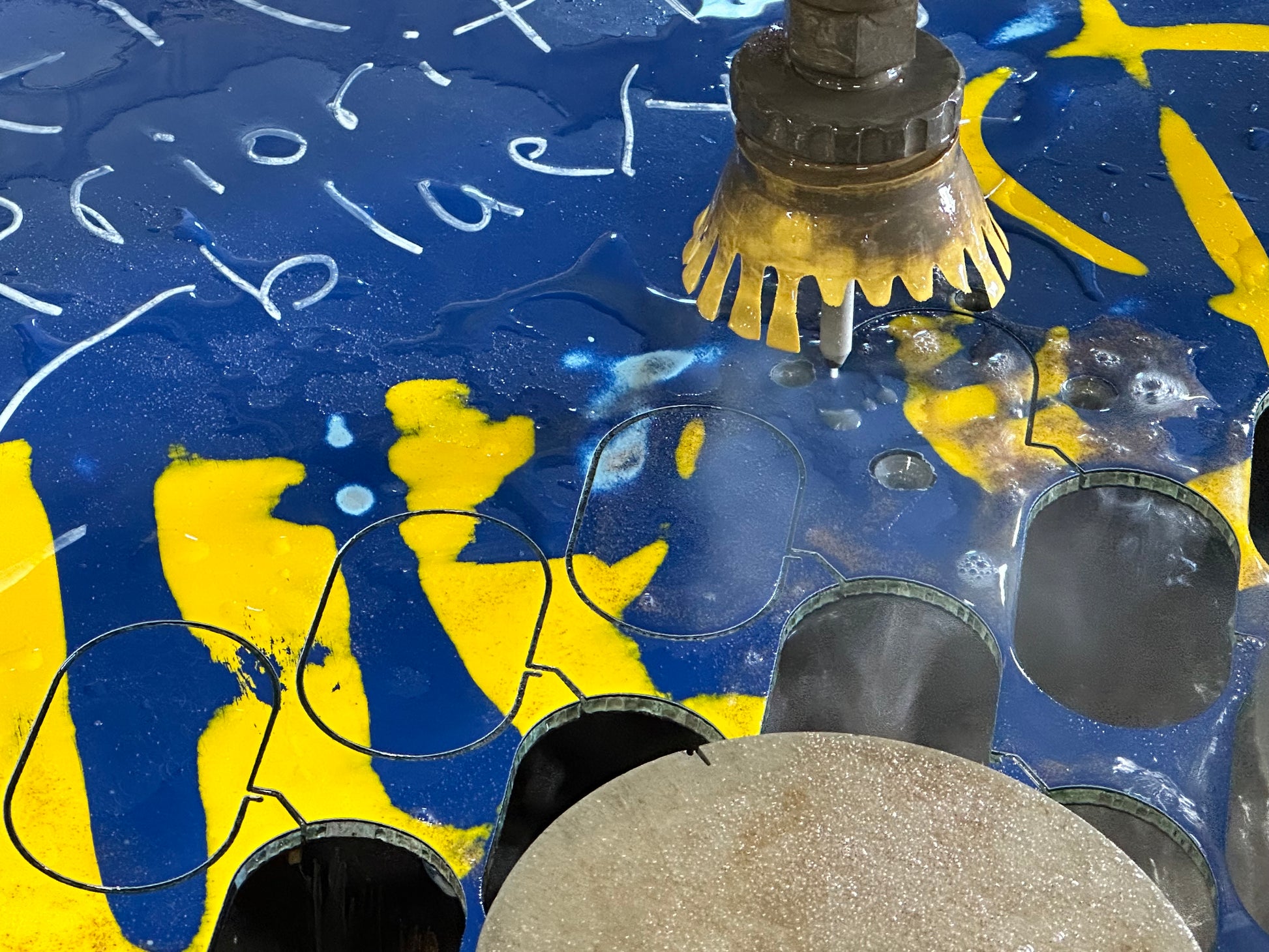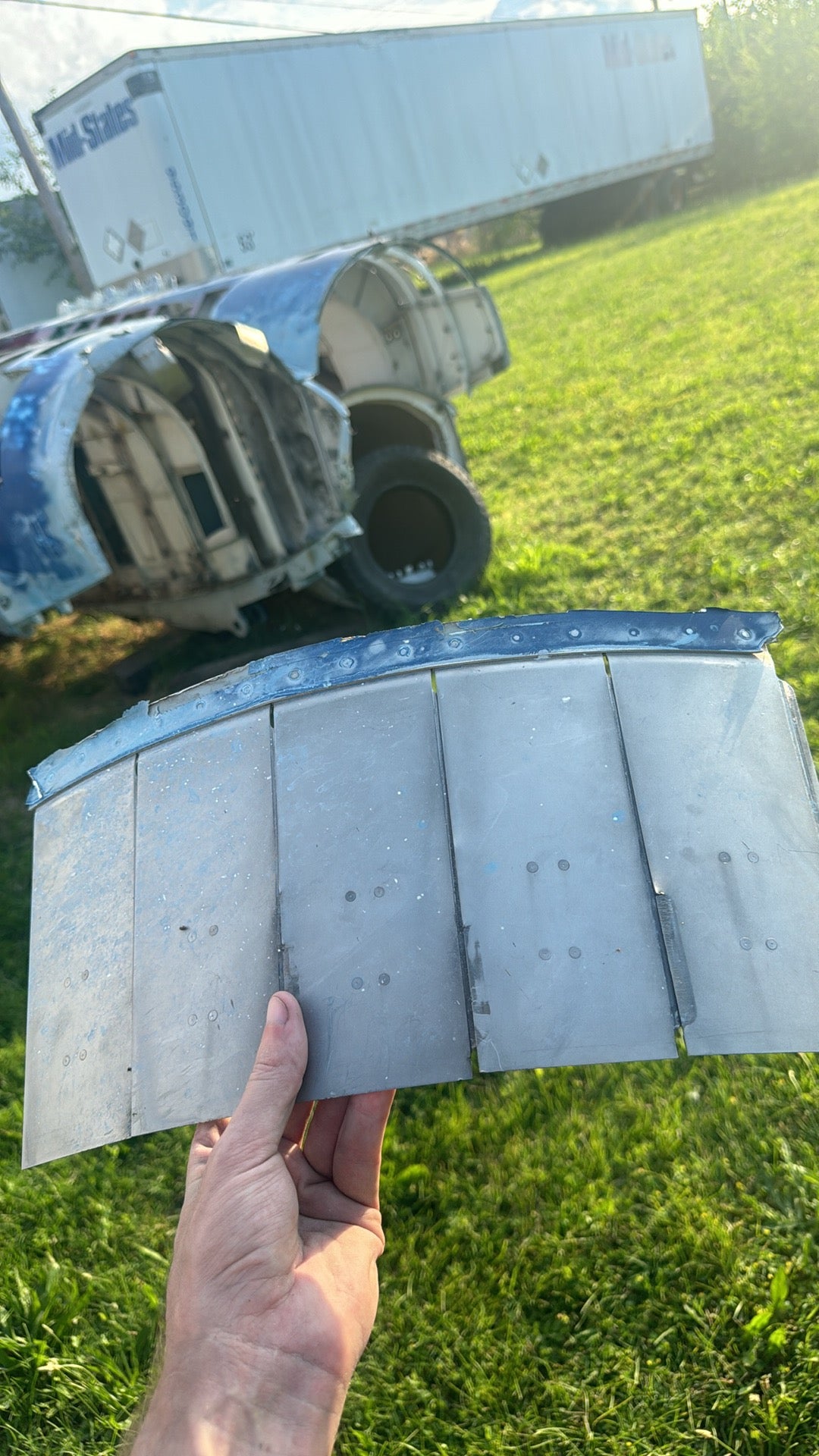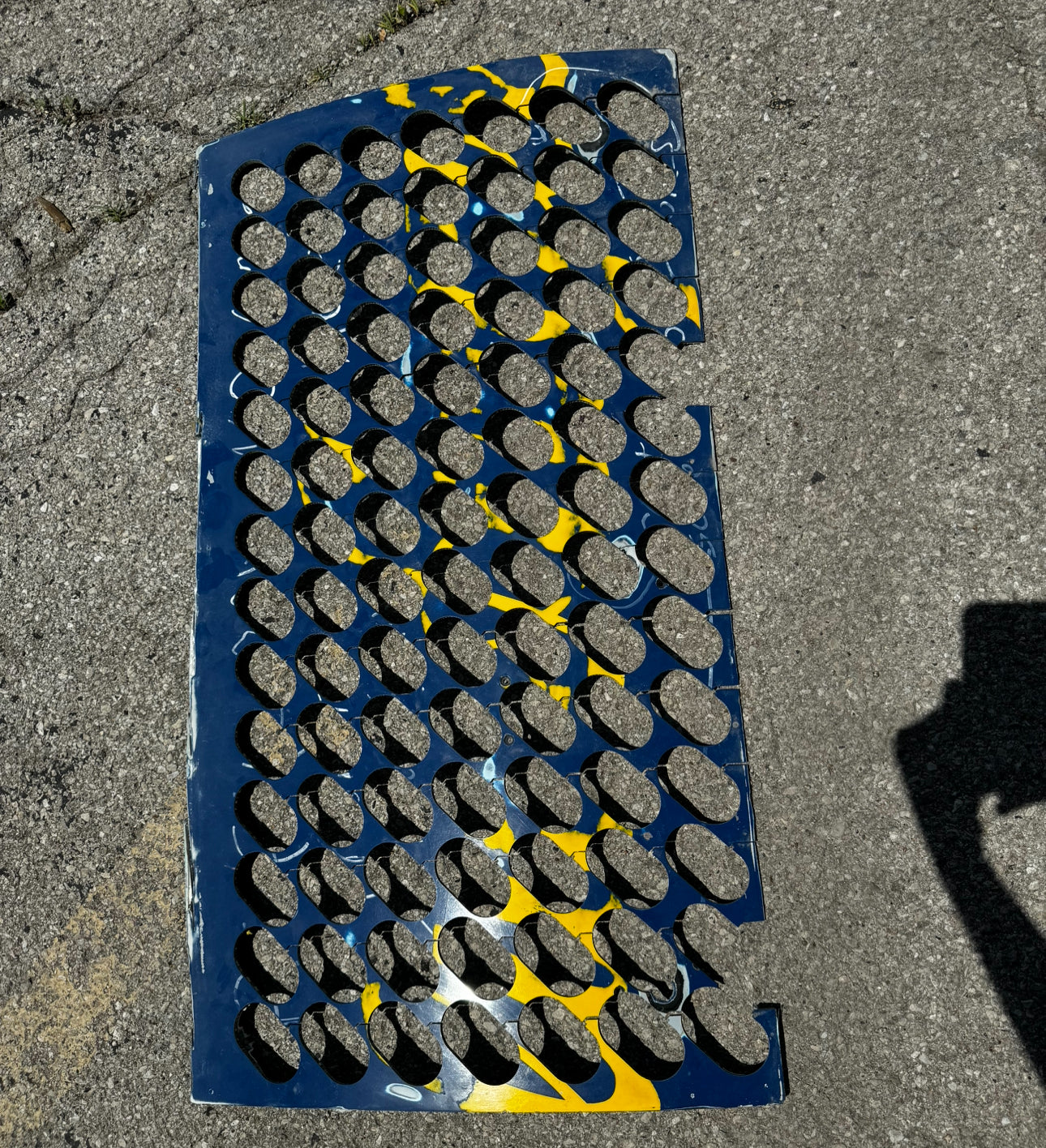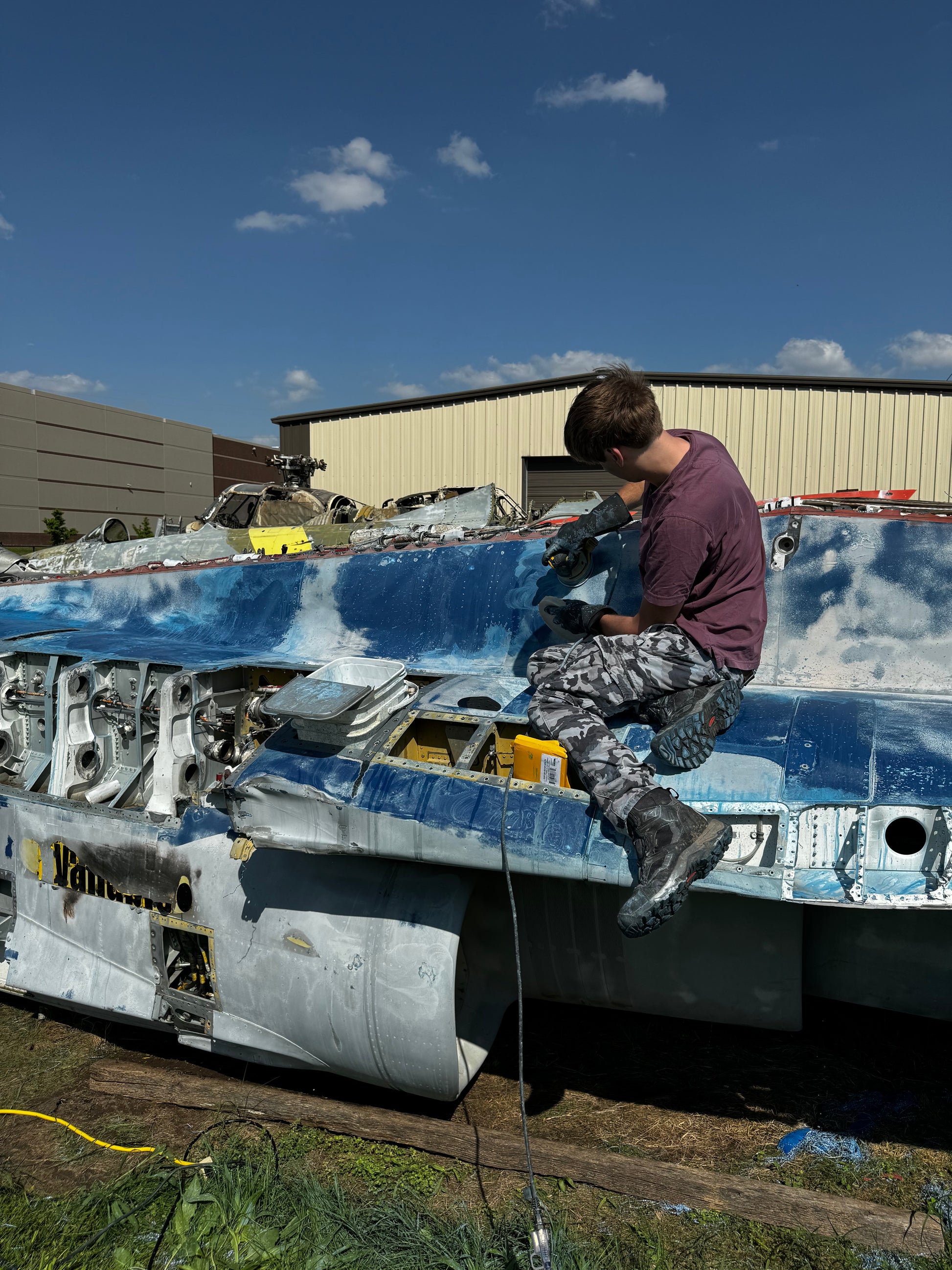Blue Angels F/A-18A Hornet
Blue Angels F/A-18A Hornet
Couldn't load pickup availability
Our F/A-18A Hornet, BuNo: 161973, boasts an illustrious history as a former Blue Angels aircraft. Serving as the #1 lead aircraft, it was piloted by Commander Pat Moneymaker during the 1990 season, and by Captain Greg Wooldridge in the 1991-1992 seasons. Subsequently, it served as the #5 Angel piloted by Ken Switzer in the 1993 season, before being retired in 1994.
Captain Greg Wooldridge, the only three-time Blue Angels Boss, reunites with his former Blue Angels Hornet he flew in Moscow, Russia at our Saint Louis, MO storage lot.

Our BuNo: 161973 Leading the formation at an airshow. Credit: Ian Abbott
Our distinguished Blue Angel was involved in a midair collision with Blue Angel #2 (BuNo: 161524), piloted by Captain Chase Moseley on January 23, 1990, at NAS El Centro, California. Despite sustaining right wing damage, our aircraft BuNo: 161973 landed safely, while Blue Angel #2 crashed, with Captain Moseley successfully ejecting. Following a right-wing replacement, our Blue Angel resumed service and completed the 1990-1993 seasons.
In 1992, our F/A-18A Hornet undertook a European Tour, visiting the UK, Italy, Spain, Bulgaria, Romania, Sweden, Finland, and culminating in Moscow, Russia, after the fall of the Soviet Union. It was flown by Captain Gregory Wooldridge during this tour, which was marked by a historic performance with the Russian Knights demonstration team over Moscow, on September 5th, 1992, with 161973 as the #1 lead aircraft.


Our Blue Angel, bottom right, partial. Pictured in Moscow, Russia with the Russian Knights.
Our aircraft completed one more season in 1993, renumbered as the #5 Blue Angel and piloted by Captain Ken Switzer. It was decommissioned from service in 1994 and subsequently found its way into private hands.
In 2004, our F/A-18 made headlines when it appeared on eBay. In 2023 we rediscovered this aviation treasure in a state of disrepair, and immediately purchased it.

Our Blue Angel at our lot in St. Louis, MO.
We had to sand down the gray primer that a previous owner sprayed on our Blue Angels Hornet and then had to buff the original paint back to its original luster. Most tags will retain the original blue gloss, but we have other interesting variants that showcase the light blue primer under the Blue Angels paint as well.

Panel close-up. Credit
We are currently restoring the cockpit and have artfully recycled parts of the fuselage for TransportTags. The legacy of arguably the most historic Blue Angels aircraft of all time will live on — not only with the cockpit being restored in the future, but also through Blue Angels TransportTags. These tags will be cherished by our collectors as unique pieces of aviation treasure that tell the tale of this storied aircraft, the pilots who flew it, and the places around the world it visited. (Please note that Transport Tags LLC is NOT an authorized or licensed distributor of the Blue Angels, the U.S. Navy, or McDonnell-Douglas/Boeing Aircraft Company, and uses their name, markings, etc., for identification purposes ONLY in accordance with the Lanham Act).
Vehicle History
Vehicle History
The F/A-18 Hornet revolutionized the Blue Angels' performances by combining advanced technology with exceptional versatility. Developed by McDonnell Douglas and Northrop in the 1970s, the Hornet was designed as a multirole combat jet capable of both air-to-air and air-to-ground missions. Its twin-engine design, supersonic speeds, and agility made it a perfect fit for the demanding maneuvers performed by the Blue Angels. The Hornet's ability to operate from aircraft carriers and land bases further enhanced its operational flexibility, making it a formidable asset for both the Blue Angels and the U.S. Navy.
The legacy of the F/A-18 Hornet extends beyond its role with the Blue Angels. As one of the most successful and widely used fighter jets in history, the Hornet has served in numerous air forces around the world. Its combat effectiveness has been proven in various conflicts, including the Gulf War, where it played a crucial role in achieving air superiority and conducting precision-guided strikes. The Hornet's adaptability, reliability, and advanced avionics have made it a cornerstone of modern naval aviation, ensuring its continued relevance even as newer aircraft are introduced.
The Blue Angels' performances have had a profound impact on aviation enthusiasts and the general public alike. Their breathtaking displays of skill and teamwork showcase the pinnacle of aerial precision, leaving spectators in awe. The Blue Angels' influence extends beyond airshows, as they engage in community outreach, visiting schools, hospitals, and other organizations to share their passion for aviation. Through these interactions, the Blue Angels inspire future generations to pursue careers in aviation and instill a sense of pride in the capabilities of the U.S. Navy and Marine Corps.
The F/A-18 Hornet's success can be attributed to its cutting-edge technology and continuous upgrades. The aircraft's advanced avionics, including radar systems, electronic warfare capabilities, and integrated weapon systems, provide pilots with unparalleled situational awareness and combat effectiveness. The Hornet's fly-by-wire control system enhances maneuverability and stability, allowing pilots to execute precise maneuvers with ease. These technological advancements have ensured that the F/A-18 Hornet remains a formidable aircraft in modern warfare, capable of meeting the evolving challenges of the 21st century.
In recent years, the Blue Angels have transitioned from the legacy F/A-18 Hornet to the more advanced F/A-18E/F Super Hornet. This transition represents a significant upgrade in terms of performance and capabilities. The Super Hornet features improved engines, increased payload capacity, and enhanced avionics, enabling the Blue Angels to push the boundaries of their aerial displays even further. The transition also highlights the continued evolution of naval aviation and the commitment to maintaining the highest standards of excellence in airshow performances.
As the Blue Angels continue to soar with the Super Hornet, the legacy of the F/A-18 Hornet remains deeply ingrained in the history of naval aviation. Many legacy Hornets have been retired from active service and preserved in museums, where they serve as a testament to the aircraft's contributions to military aviation. These iconic jets, once flown by the Blue Angels and other squadrons, stand as symbols of technological innovation, bravery, and the relentless pursuit of excellence. The preservation of these aircraft ensures that future generations can appreciate their historical significance and the impact they had on aviation.
The Blue Angels and the F/A-18 Hornet share a legacy of excellence that continues to inspire and captivate audiences worldwide. The Blue Angels' precision aerobatics and the F/A-18 Hornet's combat prowess have left an indelible mark on aviation history. As the Blue Angels transition to the Super Hornet and new aircraft emerge, the legacy of the F/A-18 Hornet will endure, reminding us of the remarkable achievements and advancements in naval aviation. The Blue Angels and the F/A-18 Hornet exemplify the dedication, skill, and innovation that define the U.S. Navy and Marine Corps, ensuring that their legacy will be remembered for generations to come.
Product Specifics
Product Specifics
The process of restoring the original Blue Angel paint scheme - by removing primer that had been applied by a previous owner - was a long and arduous task. Careful attention to buffing and sanding the surface restored most of the classic Blue Angel blue. Other tags, due to weathering, primer removal, location on aircraft, etc., showcase interesting and rugged color schemes and textures.
Please note:
Sharp and Rough Blue/Yellow Tags will either be metal or a carbon honeycomb and shipped at random.
Vehicle Stats
Vehicle Stats

MANUFACTURER: McDonnell Douglas
MODEL: F/A - 18A Hornet
LENGTH: 56 ft 1 in (17.1M)
WINGSPAN: 40 feet 4in (12.3M)
ENGINES: General Electric F404 Afterburning Turbofan
TOP SPEED: 1,190 MPH (1915KPH)/Mach 1.8
RATE OF CLIMB: 50,000 ft/min (250 m/s)
CEILING: 50,000 feet
G-FORCE RATING: 7.5
Product Dimensions
Product Dimensions
Card Dimensions
Length: 5 1/2"
Width: 3 1/2"
Tag Dimensions
Length: 3"
Width: 1.75"
Thickness: 1mm - 10mm
Disclaimer
Disclaimer
TransportTags are unique, handcrafted pieces made from genuine vehicle skin. Features like scratches, blemishes, or minor discolorations testify to their unique vintage appeal and authenticity. By purchasing, you accept the product may differ slightly from website images. Transport Tags LLC uses authentic material from transportation vehicles, potential containing hazardous substances. Not intended for ingestion, inhalation, or use by small children. Transport Tags LLC is an independent company, not affiliated with, sponsored or endorsed by any entities. We use branded names and insignia for identification under the provisions of the Lanham Act, without implying any association or endorsement. For more information, read our detailed product safety and legal information here.
Share
